Why is it that border crossings seem to be among the grubbiest and smelliest places in the world? The Bolivian border officials were at lunch so we sat with the windows closed and waited for them to return. Bolivia is the fifth largest country in South America and is totally landlocked. It is also reputed to be South America’s poorest country. Finally, the border officials returned and with all our documents signed and stamped, we drove up to the large boom across the road. No one came to open it up so we did it ourselves and drove into Bolivia. We drove along the shore of Lake Titicaca and onto a ferry across to Copacabana a little town on the shore. The ferry rocked and rolled as I drove on and I hoped I would not sink.
Enlarge

Adventurouspirits
Enlarge
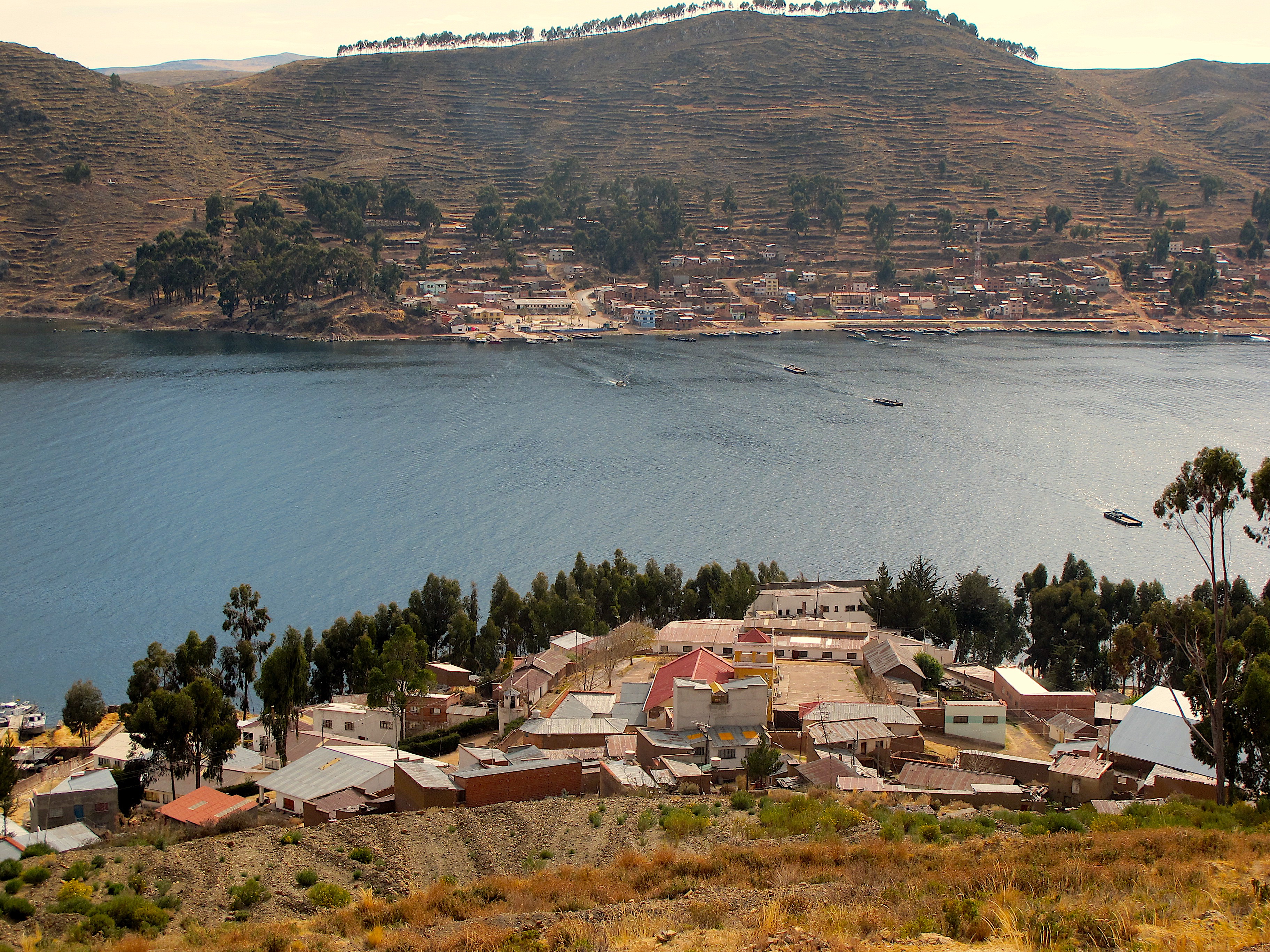
Adventurouspirits
Enlarge

Adventurouspirits
Copacabana is small touristy town from which many make the trip across the lake to the Isla de Sol. We camped in the parking lot of Hotel Gloria and lay awake all night listening to the barking dogs. At sunrise, the trucks and buses parked alongside us started up and diesel fumes engulfed us. It was time to head out destination La Paz, Bolivia’s largest city and one of the world’s highest cities at about 4km above sea level.
Enlarge
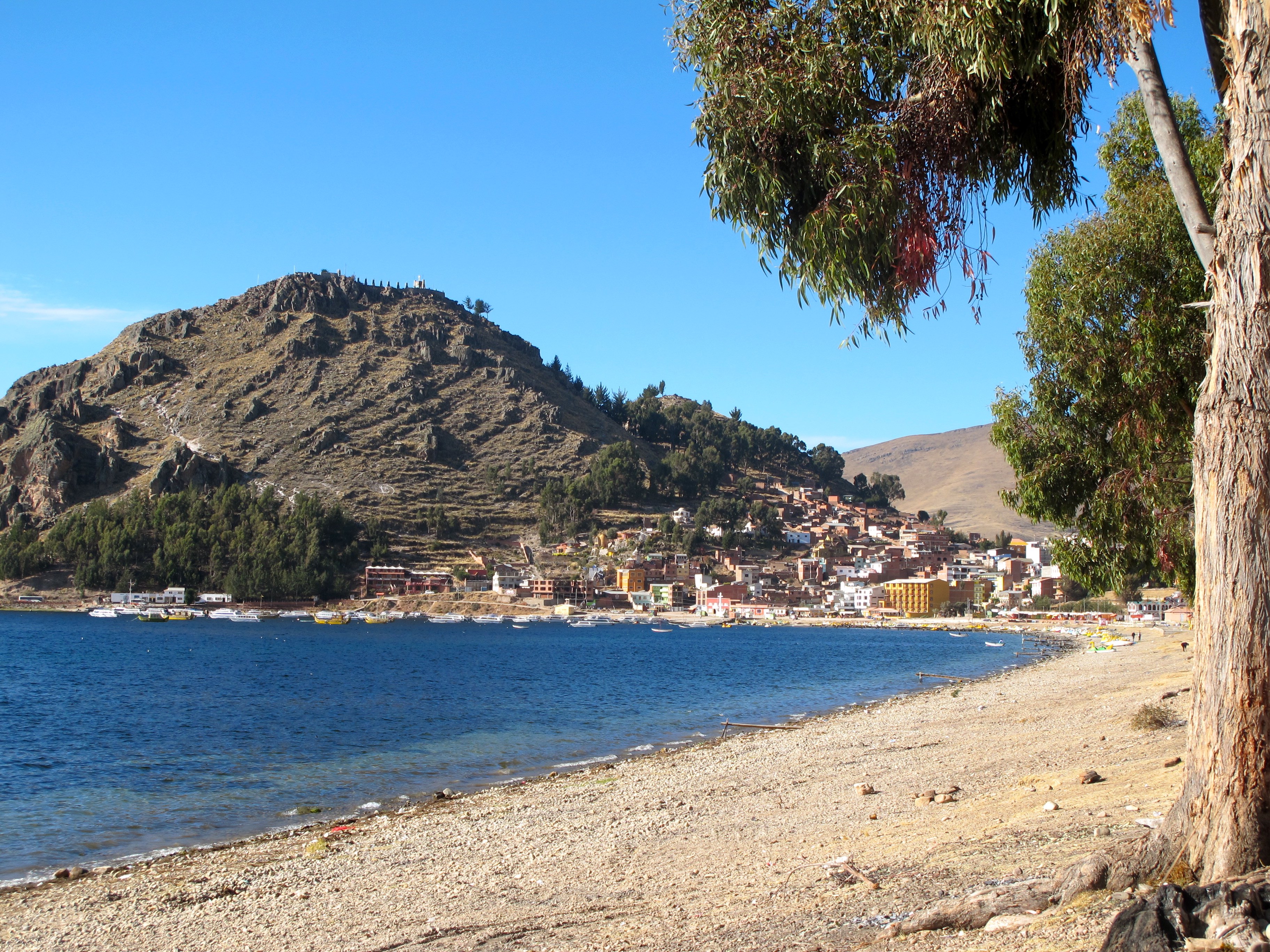
Adventurouspirits
We drove into El Alto, which at 4150m (13,615) is even higher than La Paz and overlooks the city. La Paz is located in the valley below. Houses and buildings literally cling to the sides of the mountains. Driving up and down the narrow steep streets ones seems to defy gravity and actually requires a head for heights. It is hard to get lost one just has to head downhill to find the main road that runs through the city across the bottom of the valley. Earlier this year heavy rains caused massive landslides and houses, roads and people were swept down the mountainside. It certainly seems like a city clinging to the sides of mountains and on borrowed time.
Enlarge

Adventurouspirits
We headed for the Oberland Hotel which allows camping and is just south of La Paz.
We decided to have the truck serviced in La Paz so headed into the city on Thursday as the locals were planning a city shut down strike on Friday. Ernesto is the mechanic that all overlanders use to have their vehicles serviced. While he serviced the truck, we went down to meet fellow travelers Miin and Niel in the city centre.
Enlarge

Adventurouspirits
We flagged down a cab and headed for the city cemetery. Like in most South American cemeteries, bodies are buried in a traditional grave or crypt. Then within 10 years, they are disinterred and cremated. The families purchase or rent space in the cemetery walls for the ashes. The spaces are decorated by the families, which are mostly behind glass doors. Fresh flowers, toys, articles of food and drinks and other mementos are all placed within the space.
Enlarge

Adventurouspirits
Enlarge

Adventurouspirits
We wandered around before heading down the steep alleys and streets back to the main road that passes through La Paz. Street vendors flow onto the sidewalks and alleyways. It is bustling with life, colours, smells and noise. It feels so great it is almost like being back in Africa.
Enlarge
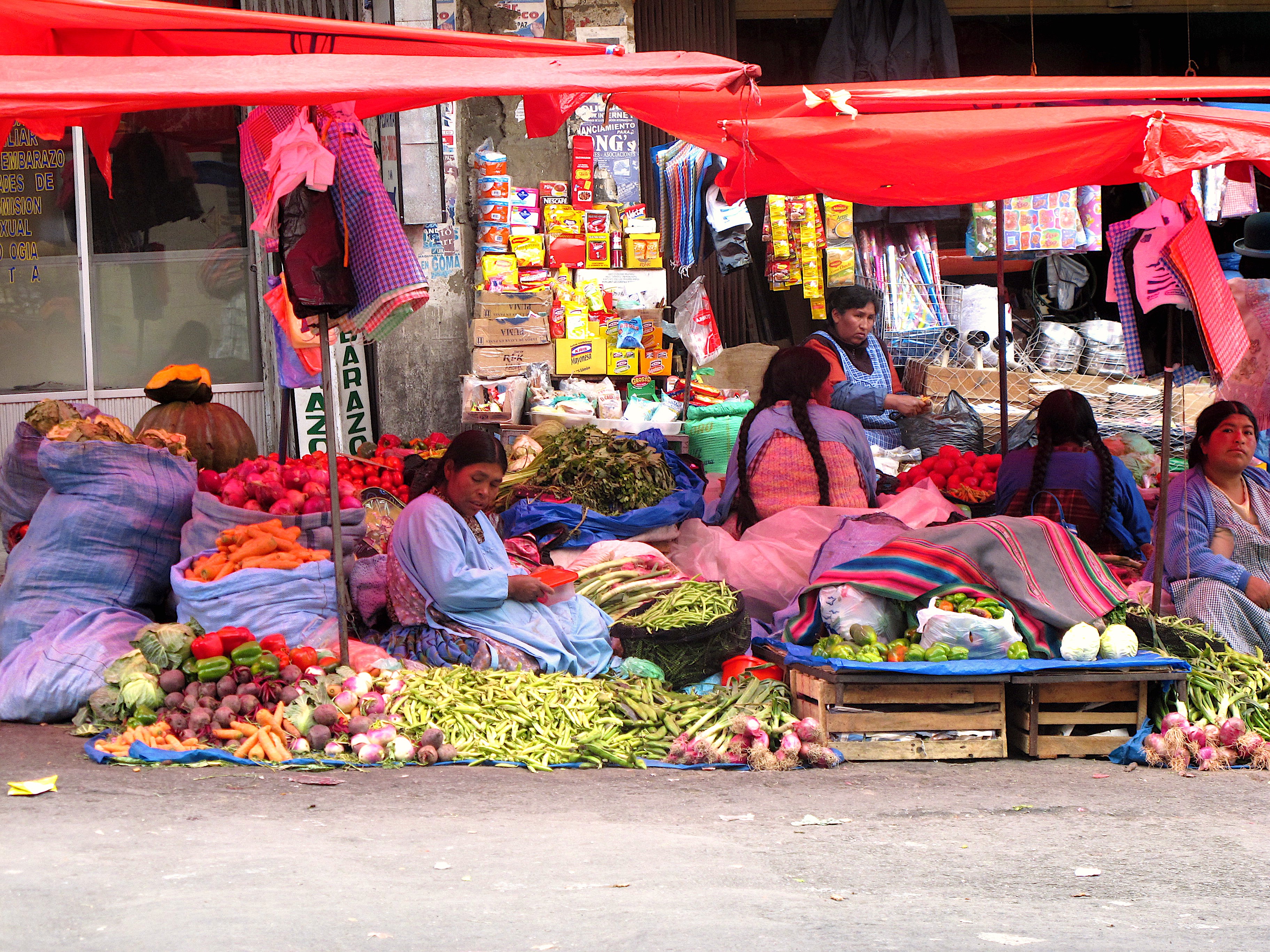
Adventurouspirits
Enlarge

Adventurouspirits
The Bolivian Andean women of indigenous descent wear skirts of many layers called apollera. The skirt was originally a Spanish peasant skirt that the colonial authorities forced the indigenous women to wear. Today they wear it with pride along with a silky shawl (manta) and a bowler hat that surprisingly was adopted from the British.
Enlarge

Adventurouspirits
Many sling a rectangle of hand-woven cloth (aguayo) decorated with colourful horizontal bands across their backs carryall from children to coca leaves
Enlarge

Adventurouspirits
Enlarge

Adventurouspirits
We head to the witches market (Mercado de Hechieceria) where one can buy herbal and folk remedies. I buy a little frog, which the woman blessed for me, and I am told I will soon have some money. I decline buying a llama foetus, which brings luck if placed under ones house. Our house is on the truck and travelling with a llama foetus under our camper would not be a good idea. More money for travel I can handle.
Enlarge

Adventurouspirits
We finally take a cab back to the Ernesto but the truck will not be ready until the following day. We could camp in the truck in the garage but as there is, a citywide strike arranged for the following day and all roads in and out will be barricaded and blocked. We decide to head back into the centre of town and take a hotel room for the night. We would rather be where the action is than spend a day in a garage.
Enlarge

Adventurouspirits
Strike day and all is quiet, streets are empty, no diesel fumes, shoeshine youngsters play soccer in the main roads. A few women set up stands selling food and drinks, but it seemed most decided to stay at home. Rocks are placed across roads, and further out larger boulders, logs and tires block the entrances and exits from the city. Women sit in the middle of the roads knitting and catching up on news. All is quiet. Museums are closed, as are most restaurants. Tourists wander aimlessly around, cameras hanging around their necks, nothing is happening.
Enlarge

Adventurouspirits
Enlarge

Adventurouspirits
Enlarge

Adventurouspirits
After lunch, we decided to start walking back up the hill to the garage. Passing the infamous San Pedro prison, we are told to move on, no stopping. I am moving, but this is as fast as I can climb up this steep road at this altitude!! We pass the roadblocks being manned by locals and they are pleasant as they directed us up towards the garage. We arrive at the garage and the truck is ready but we are unable to leave, we need to wait until 6pm when the strike will be over. While waiting we have the truck cleaned, it looks fabulous. At 5pm, we had enough waiting and decided to head off. We arrive at the first of several roadblocks, which are no longer being manned. We manage to drive over and around all the obstacles, tires, logs, boulders etc and are soon back at camp. Made it!!
Enlarge

Adventurouspirits
Our highlight in La Paz was attending a cholitas which is a mixture of, women wrestling in traditional skirts, bedlam and crowd frenzy. We were expecting women to be wrestling other women but much to our surprise, it was women wrestling men. The first few matches are strictly between men and there is the good guy, and the bad guy. The men wrestle, the fights continue outside of the ring and soon the crowds are getting out of their chairs and heading for safety. Opponents spray each other with coke, throw around pieces of corrugated iron, bash each other with chairs and threaten their opponents with planks of wood. The referees are attacked and it appears that anything is possible. There is a sense that a rebellion is about to start. The announcer shouts over the loud speaker, vendors sell masks, drinks, bad sandwiches and cotton candy.
Enlarge

Adventurouspirits
Enlarge

Adventurouspirits
The crowds become restless, whistling and jeering waiting for their heroine to appear. The music is blaring and suddenly there is a roar; the gold silk curtain is pulled back and in walks a cholitas, dressed in a layered skirt, sandals, bowler hat and shawl. She walks around the ring, swirling her skirts and blowing kisses to the crowd.
Once inside the ring, the shawl, pins and hat are removed, and she faces her male opponent. With skirts flying and the crowd applauding, the match begins. We watch in amazement as the couple, throw and slap each other and wrestle to the ground.
Enlarge

Adventurouspirits
Enlarge

Adventurouspirits
Enlarge

Adventurouspirits
We went to be entertained and we were. We went to see a side of Bolivia that is unique and it was. A highly fun evening of amateur wrestling, chaos and theatrics. What a performance!
Enlarge

Adventurouspirits
With the local indigenous people, protesting by blocking the road leading from La Paz to the jungle we decided to fly to Rurrenabaque rather than risk not being allowed to pass through the roadblocks. We landed after a 35-minute flight in a small round cigar holder like plane on a primitive runway and taxied down the dusty road to the dilapidated terminal. Stepping out of the plane, sweltering hot humid air greeted us. We had arrived in Rurrenabaque and were about to venture into Madidi, a national park in the upper Amazon River basin. This is one of the planet’s most biologically diverse regions and is one of the world’s largest protected areas. It is also under threat with government plans to build a road cutting through the center of the park and this is the reason the locals are protesting. They are against the building of the road believing it will destroy much of the forests and surroundings, since this road would give access to more illegal logging, hunting and fishing activities.
Enlarge

Adventurouspirits
Enlarge

Adventurouspirits
Enlarge
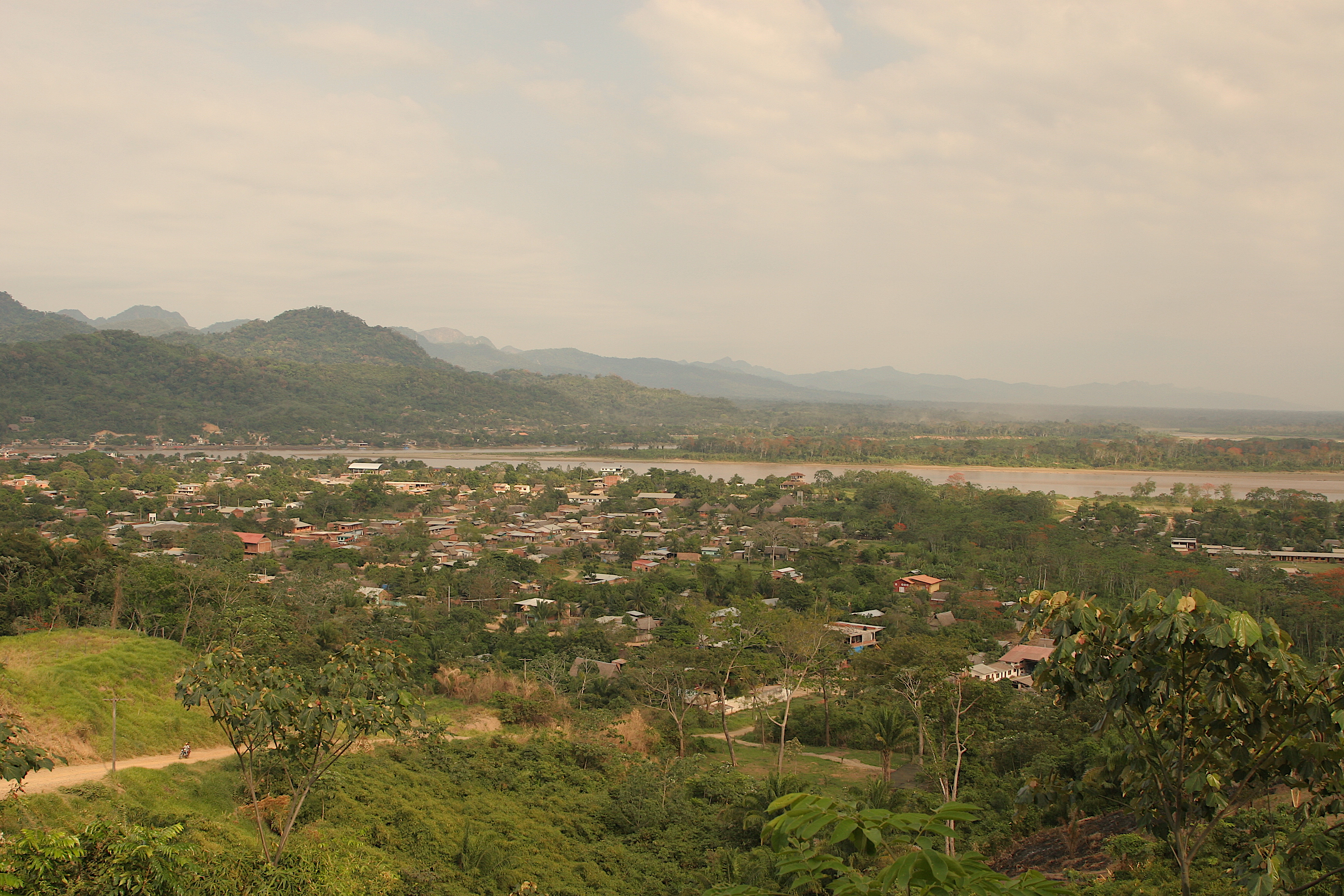
Adventurouspirits
Enlarge
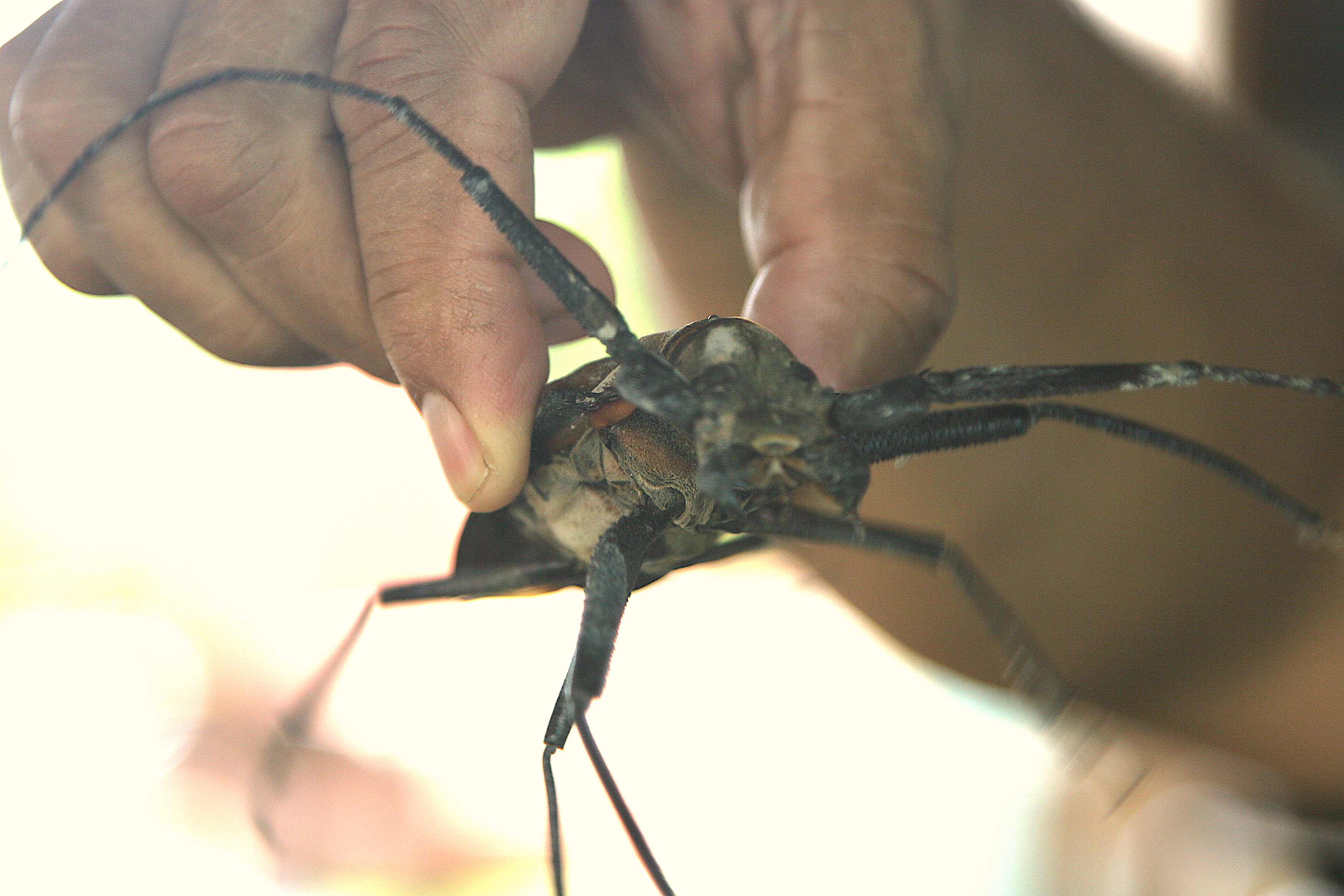
Adventurouspirits
We planned to visit Serere, a private reserve in Madidi National Park, for 3 days and then head for the pampas for 3 days. Nelson our guide loaded our luggage onto the canoe for the 3-hour trip down the Beni River to the lodge. He is a gentle man with a wide smile and a love of the Madidi where he was born. The brown sluggish river is a major tributary of the Amazon River. We motored down the shallow river. Local fishermen were camped under blue tarps along the banks or fishing from motorized dugouts. We stopped and a huge tiger catfish was bartered for with a promise to bring something back in return the following day.
Enlarge

Adventurouspirits
Enlarge
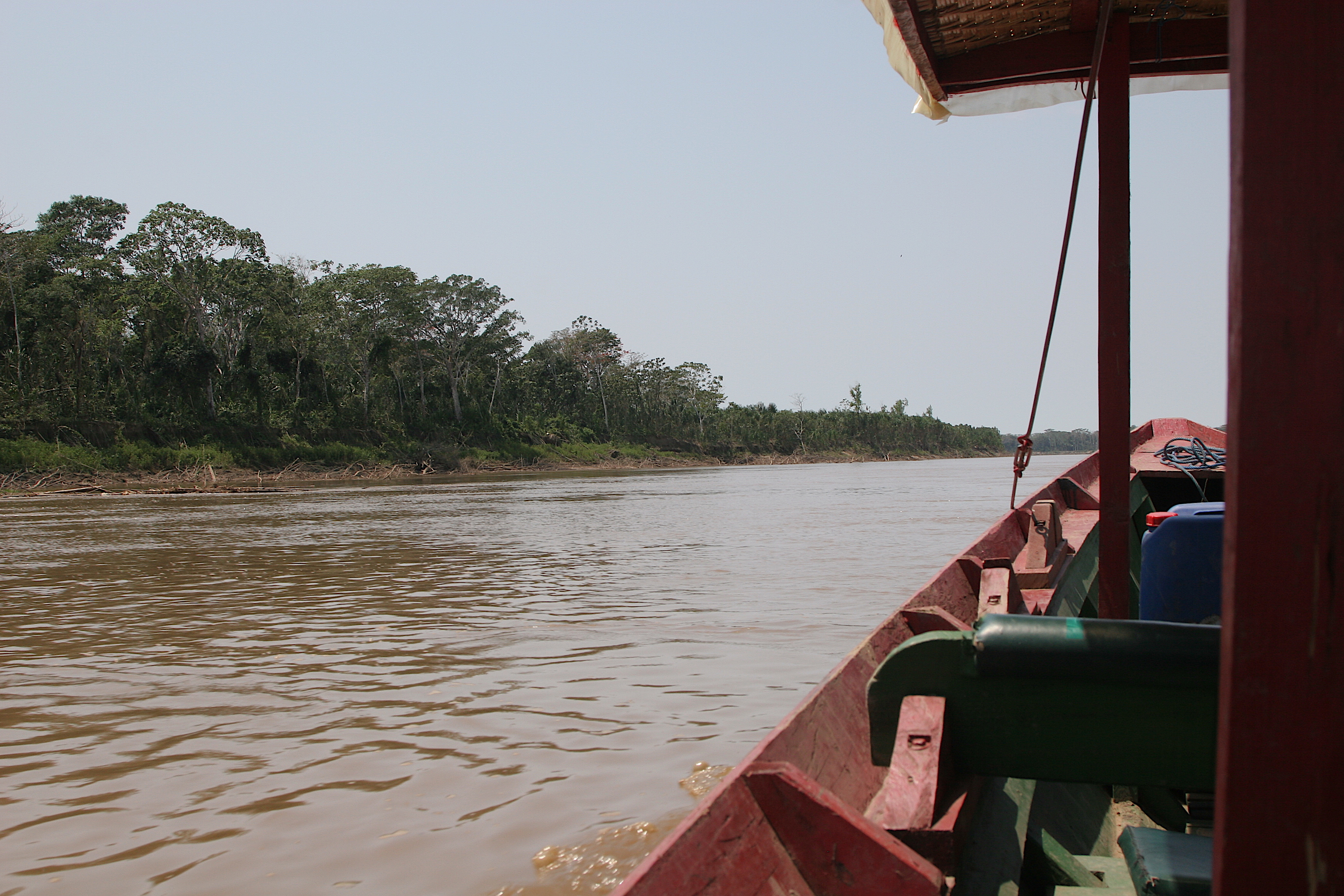
Adventurouspirits
Enlarge

Adventurouspirits
Enlarge

Adventurouspirits
We arrived at Serere and hiked the 30 minutes into the lodge. We entered a world that no longer belongs to us. It belongs to the giant trees and plants, the thousands of birds that call, shriek and sing from the branches. The spider, howler, capuchin, and squirrel monkeys that jump and swing from branch to branch through the misty forest, screeching and howling at each other. The tiny insects that burrow and hide in the ground, plants and muddy pools. Butterflies large and small, beautiful colours of yellows, blues and green flutter around us. The tiny poison frog with its bright colours warning predators of its toxicity. The tiny fire ants with jaws of a caiman had Tom writhing in pain with its sting. The strange looking Serere birds, after which the lodge is named, flutter clumsily on the banks of the river. The rare Harpy Eagle resting in a nest high above us. It is the largest and most powerful raptor found in the Americas, and among the largest species of eagles in the world. We pass a tiny nest the size of an eggcup and inside a hummingbird egg. On our return, we see the tiny little hummingbird sitting on her egg; I feel a surge of wonder at all of nature from the largest to the smallest.
Enlarge
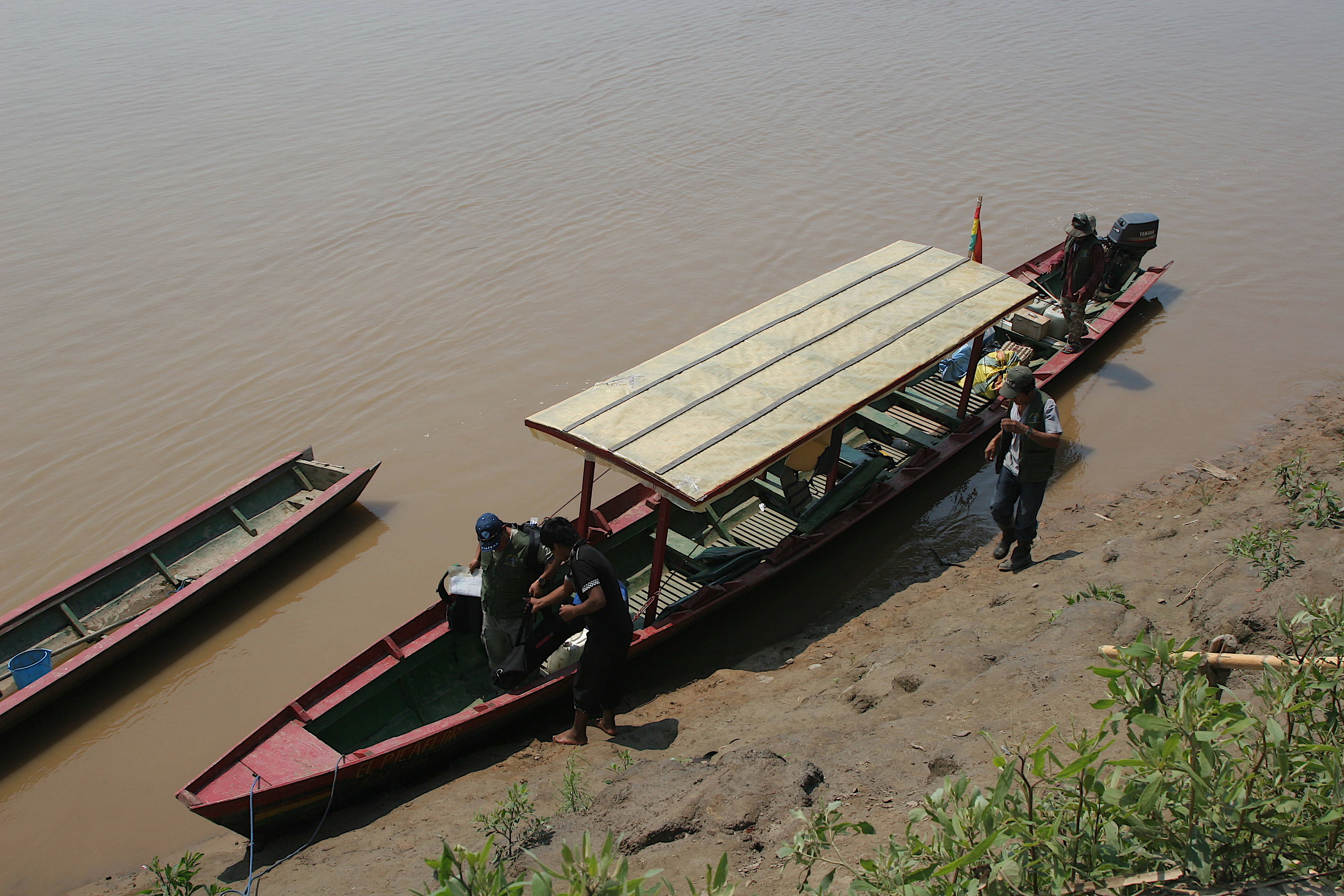
Adventurouspirits
Enlarge

Adventurouspirits
Enlarge

Adventurouspirits
Enlarge

Adventurouspirits
Enlarge

Adventurouspirits
Enlarge
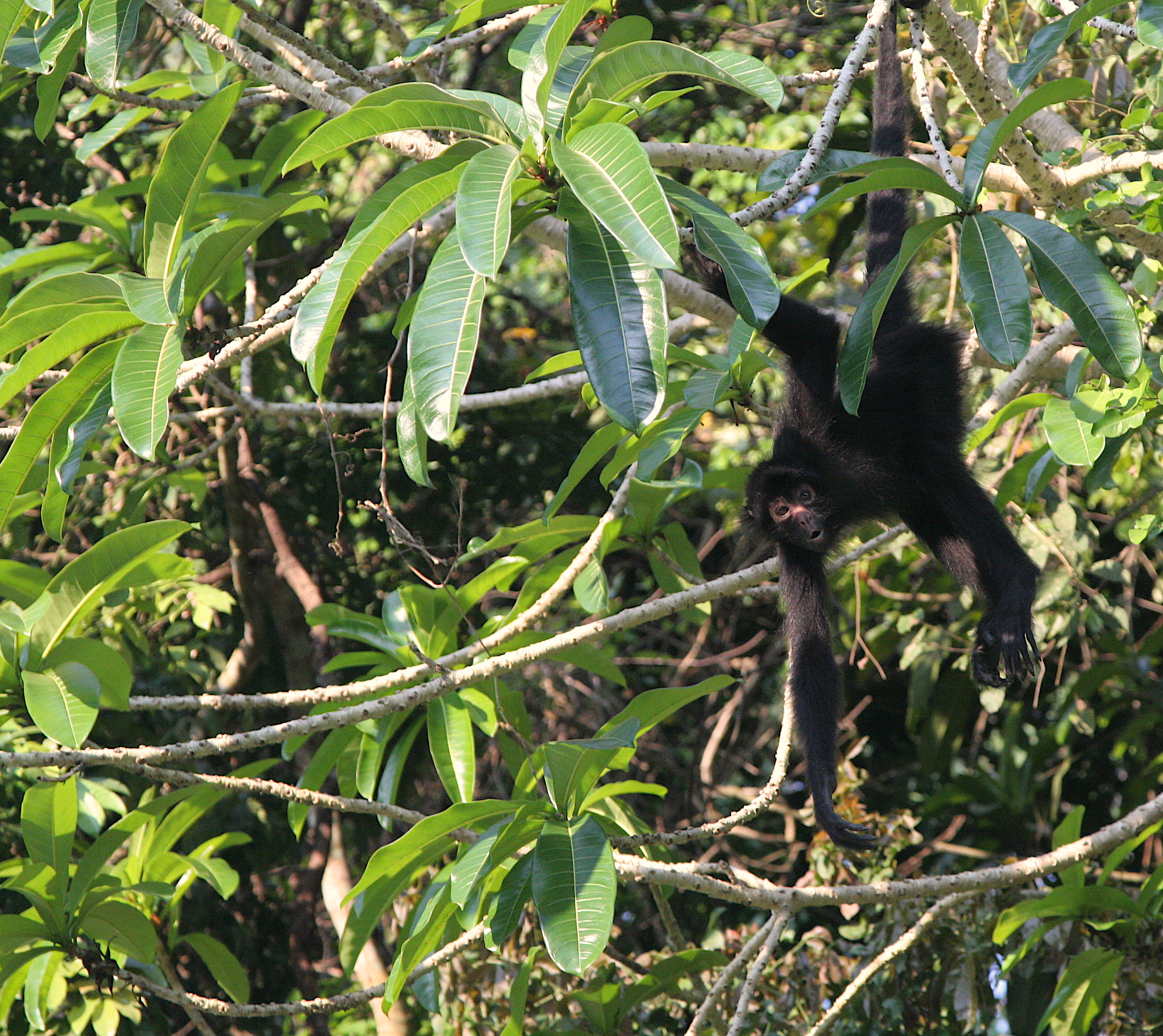
Adventurouspirits
Enlarge
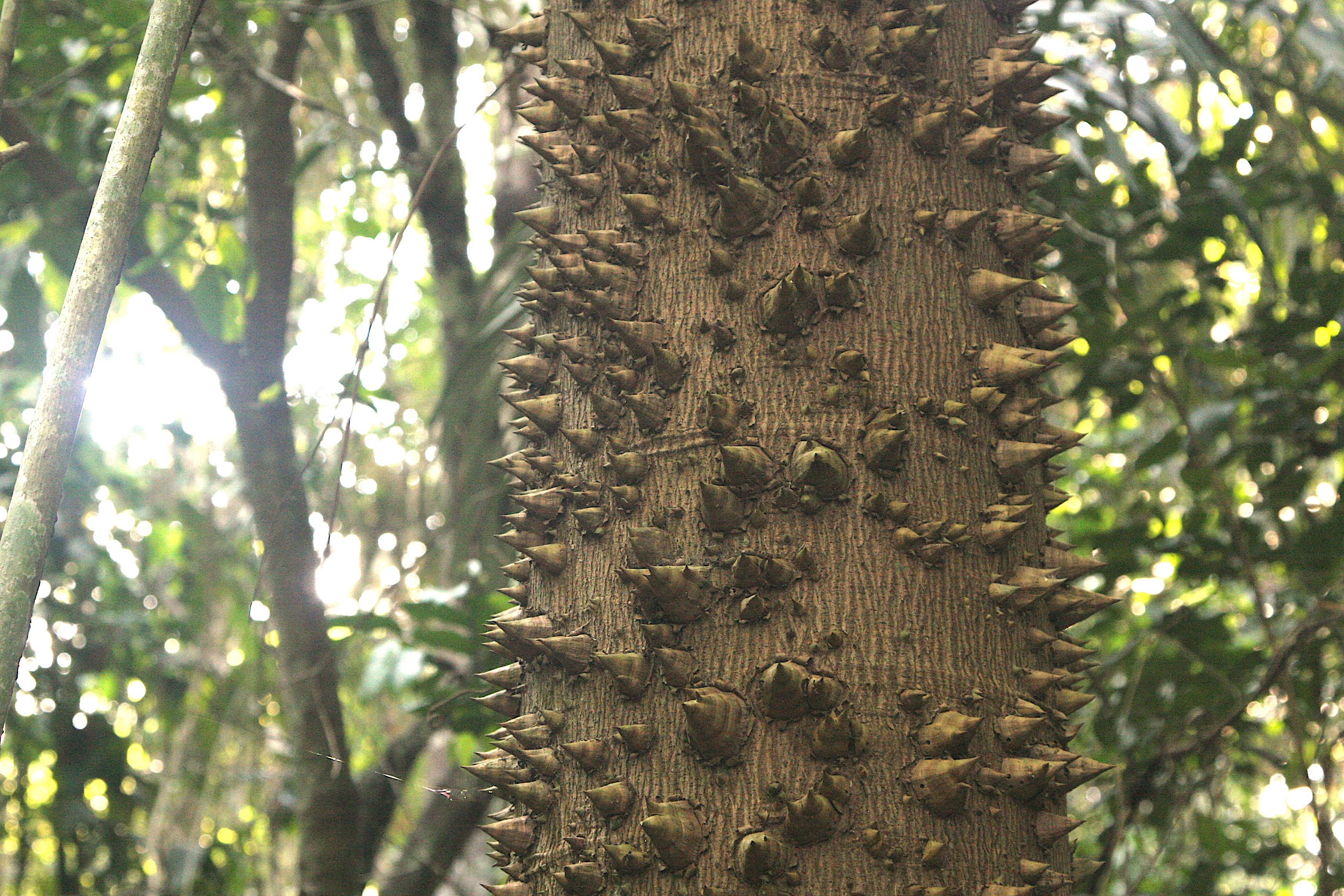
Adventurouspirits
Enlarge
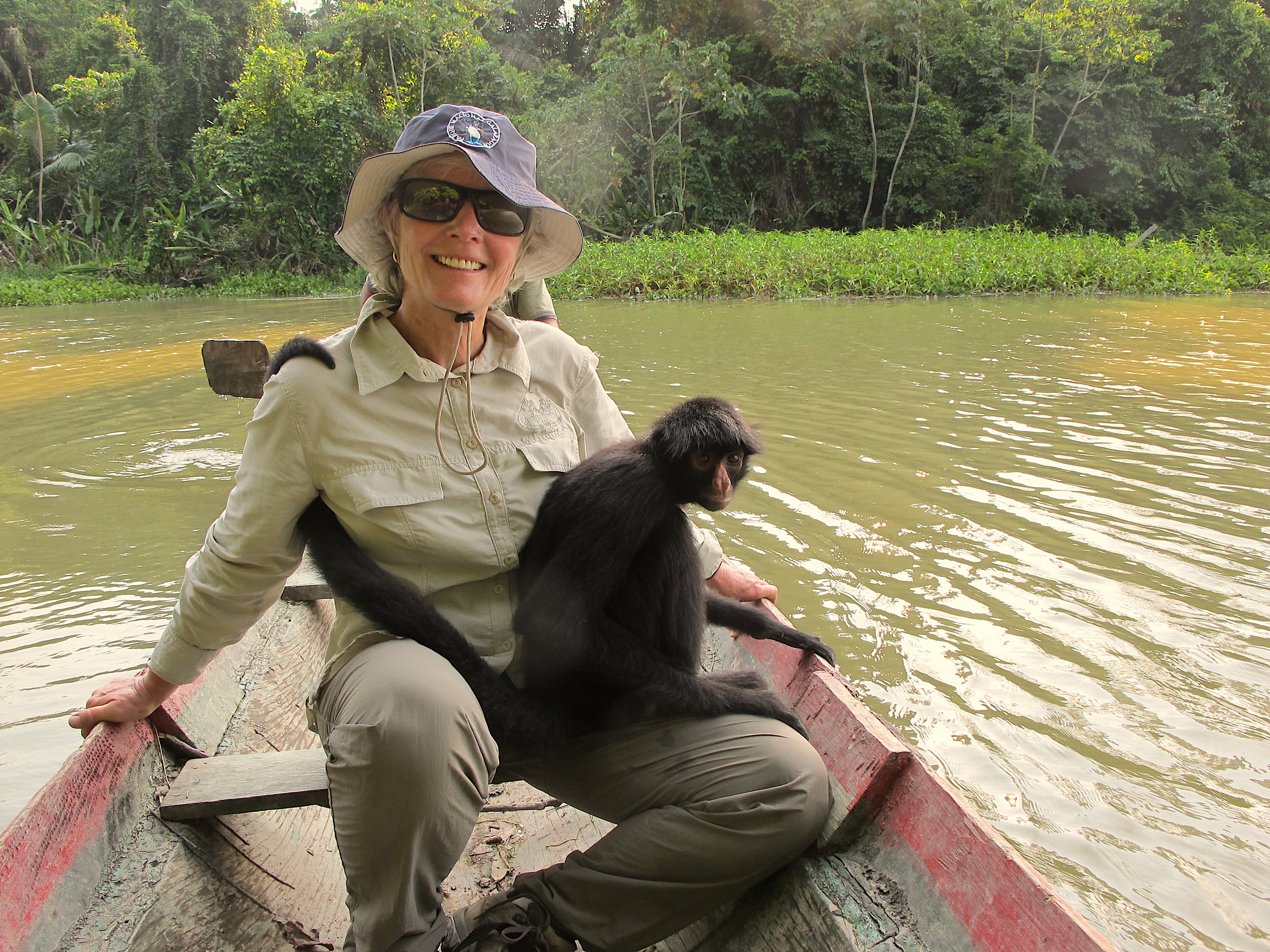
Adventurouspirits
Enlarge
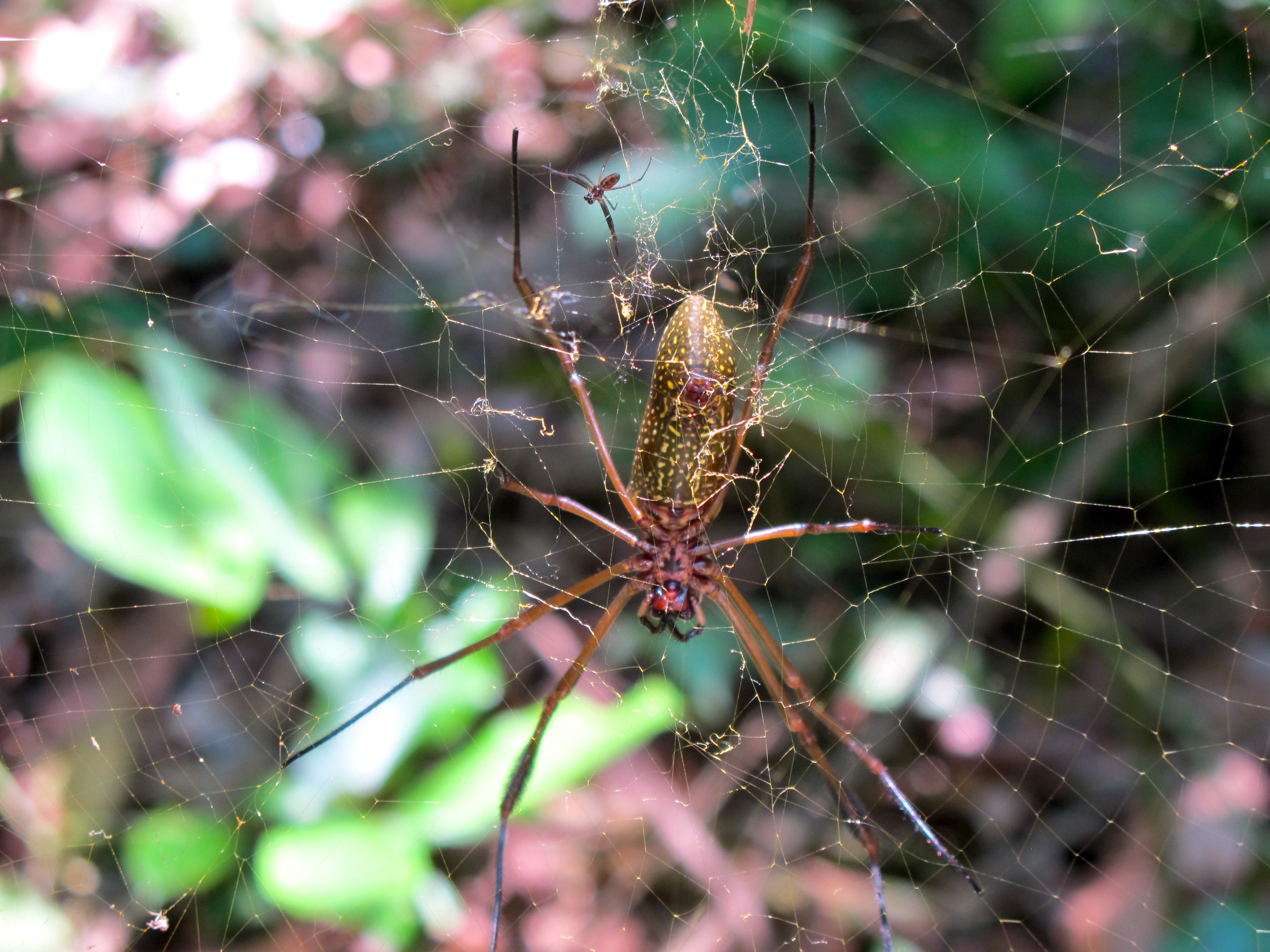
Adventurouspirits
Enlarge
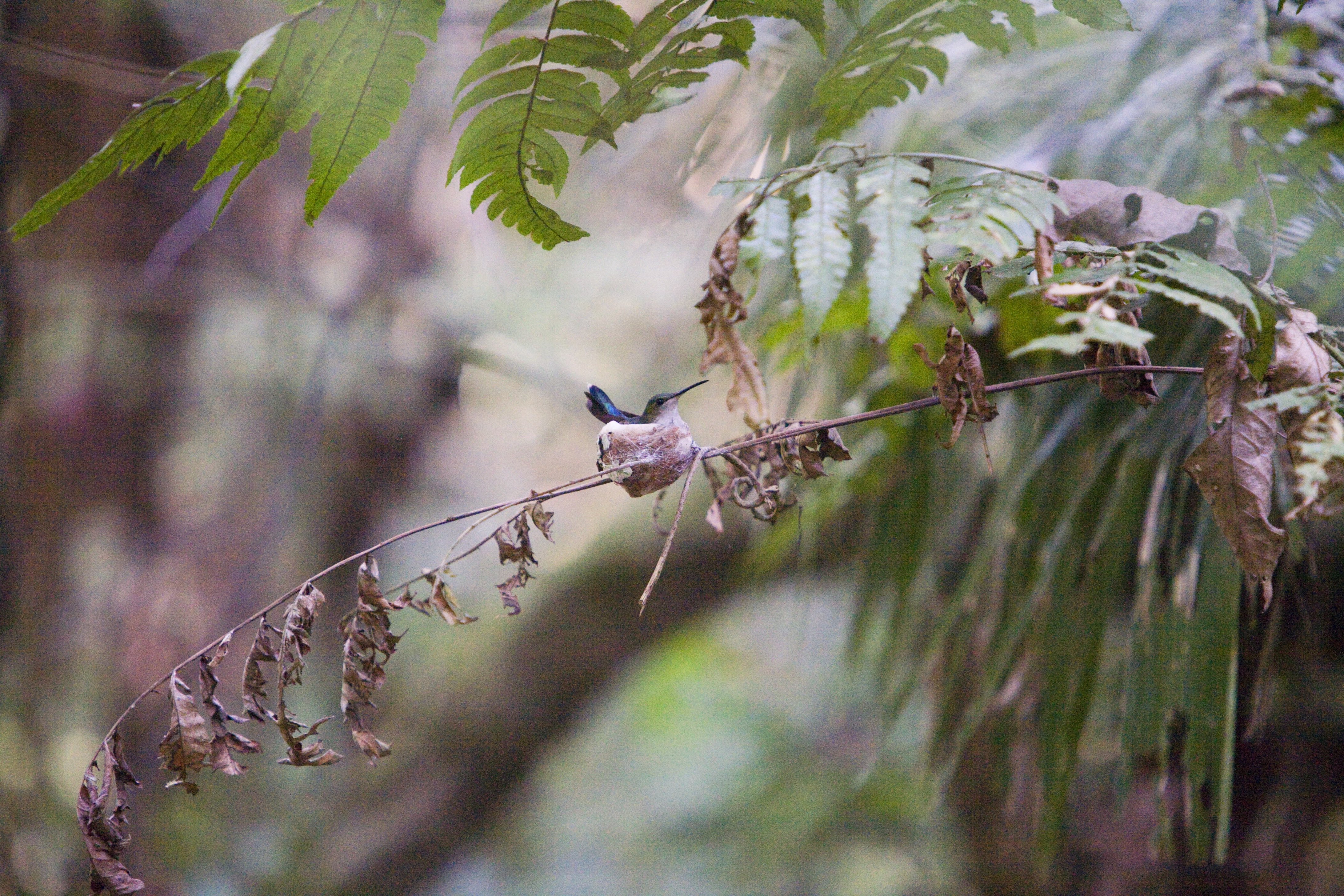
Adventurouspirits
Enlarge
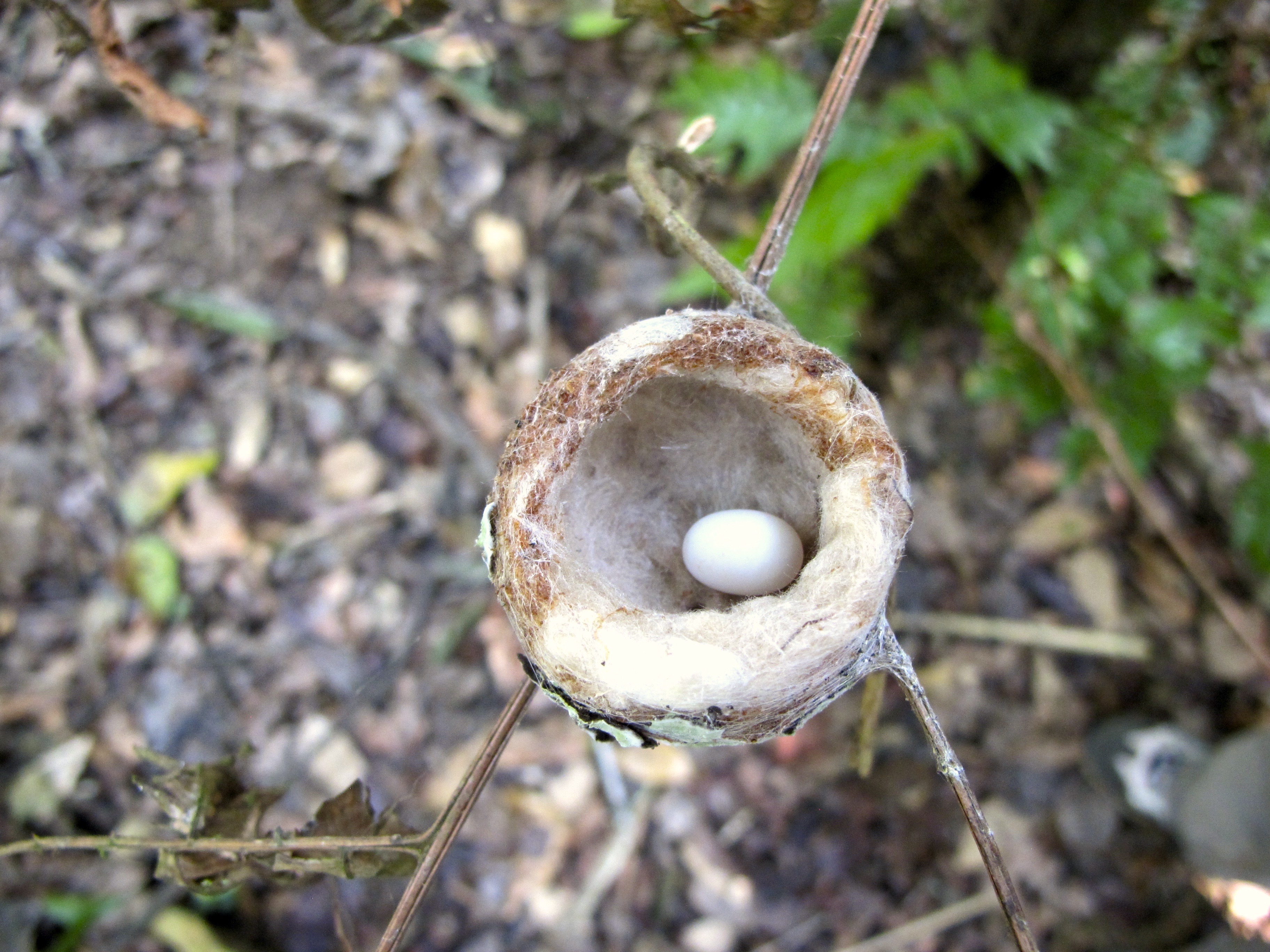
Adventurouspirits
Enlarge

Adventurouspirits
We hike to a lake and canoe across to the opposite bank. Rescued spider monkeys clamber on board the canoe and we struggle to get them to leave. The lake is calm and caiman and turtles watch us as we glide by, we are fishing for piranhas. A little piece of wood with a line and a hook with meat. The piranhas are hungry and we catch many, throwing most back after Nelson carefully removes them from the hook. Their teeth are treacherous and they need careful handling. That night we grill our catch as a storm rolls in. Tarantulas climb the walls and scurry across the kitchen floor casting shadows in the candle light.
Enlarge
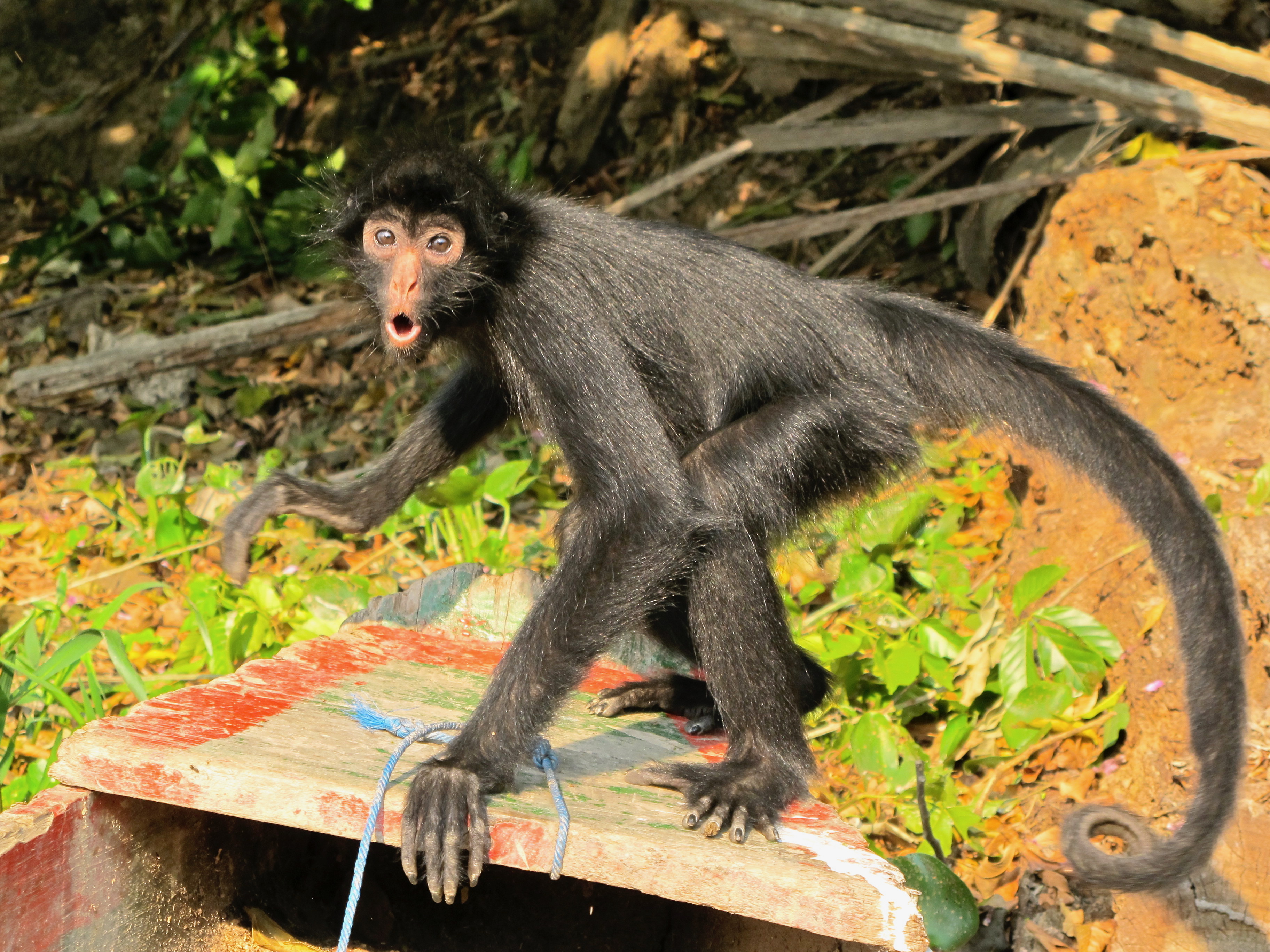
Adventurouspirits
Enlarge

Adventurouspirits
Enlarge

Adventurouspirits
Enlarge

Adventurouspirits
We lie in bed under the mosquito net, our little candle flickers and we watch the lightening and listen to the rain beat down on our palm roof. Tomorrow we leave Madidi and head for the pampas.
Enlarge
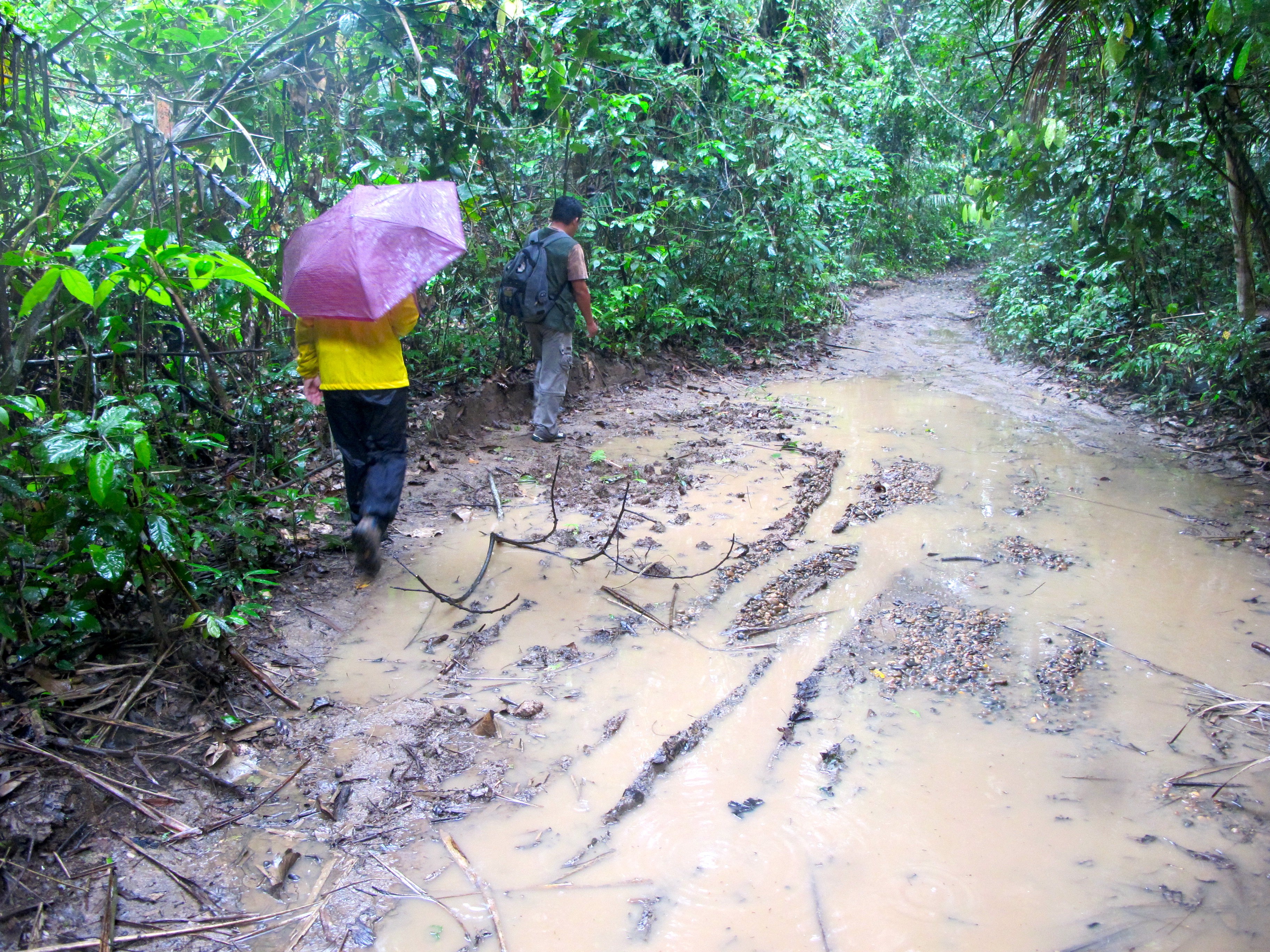
Adventurouspirits
We bid Nelson farewell. We have arranged to go into the pampas, which are primarily grassy lowlands and this vegetation makes for easier wildlife viewing. We are concerned because of the unexpected rains but our new guides assures us, they can manage the mud, “we have a jeep.” The following morning, there are delays and then Nelson appears. Our guide for the pampas had not shown up so they had arranged for Nelson to accompany us. We climbed inside the “jeep” which has signs that it has seen better days. It was in fact a Mitsubishi. We headed off for a 3-hour drive into the pampas along with Nelson and Jackie the cook. We stopped at little communities along the way to buy supplies, fresh oranges, fish, chicken and vegetables. The oranges were picked off the trees, as we waited. The road deteriorated and soon became a simple footpath way. We shook and rattled until we had a puncture.
Enlarge

Adventurouspirits
The tire was changed and we are soon back on our way. The pathway then disappeared beneath the water; the car began to slide hitting a tree as we passed. Mud flew through the open windows; it was just too hot to close them. A tree had to be moved, the machete hacked into the wood and soon our path was cleared. The vegetation changed between flat wet grasslands and thick bush and trees. Beneath it all was sticky mud. The tires struggled to grip but after several hours, we arrived at the hacienda. We looked at each other and said, “If it rains again we are going to be stuck here for days.”
Enlarge

Adventurouspirits
Chimo the Hacienda caretaker greeted us with a toothless grin. He lives alone here and looks pleased to have company. The driver returned by motorbike to Rurrenabaque leaving us stranded. Jackie cooked a great meal and together with seven large toads in the shelter, we have supper with Nelson. That night we settled onto bed that seemed better suited to a prison. Sounds of frogs croaking filled the air. It was hot and muggy, mosquitoes whined around us and we were grateful for the netting.
Enlarge

Adventurouspirits
In the morning, we headed out. Chimo had to come with us as Nelson does not know the pathways or routes. It is already hot and humid, the sun beating down on us. We waded through the mud and water, at first trying to keep our boots from filling with water and mud. Finally we gave up. The slime from the frog eggs coated our socks and boots. Chimo tells us there is a canoe and he hacks out a pathway through the bush with his machete. After a hard hike, we arrived at the Yacuma River edge. There is no canoe only caimans lazing in the sun and turtles resting on logs. Chimo shrugs his shoulders and smiles. The turtles are nesting he tells us perhaps the locals took the canoe to collect eggs. I am sweating, mosquitoes swarm around us, and it is a 2-hour hike back for lunch. Nelson keeps up his enthusiasm, pointing out the numerous birds, the fauna and flora. Chimo leading us on the path of discovery of this amazing wilderness. Despite the discomforts of hiking, we are enthralled with what we see.
Enlarge
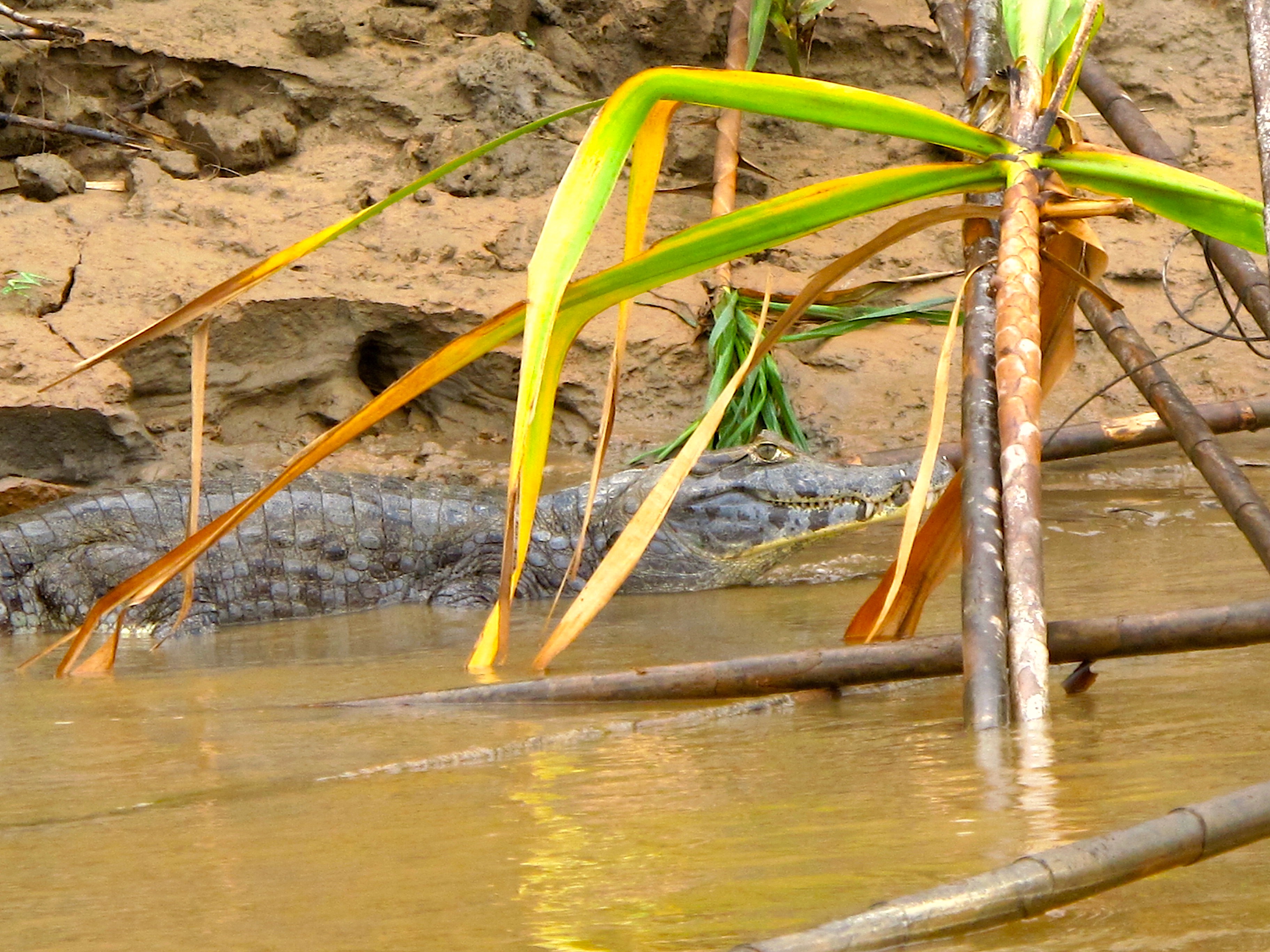
Adventurouspirits
Enlarge
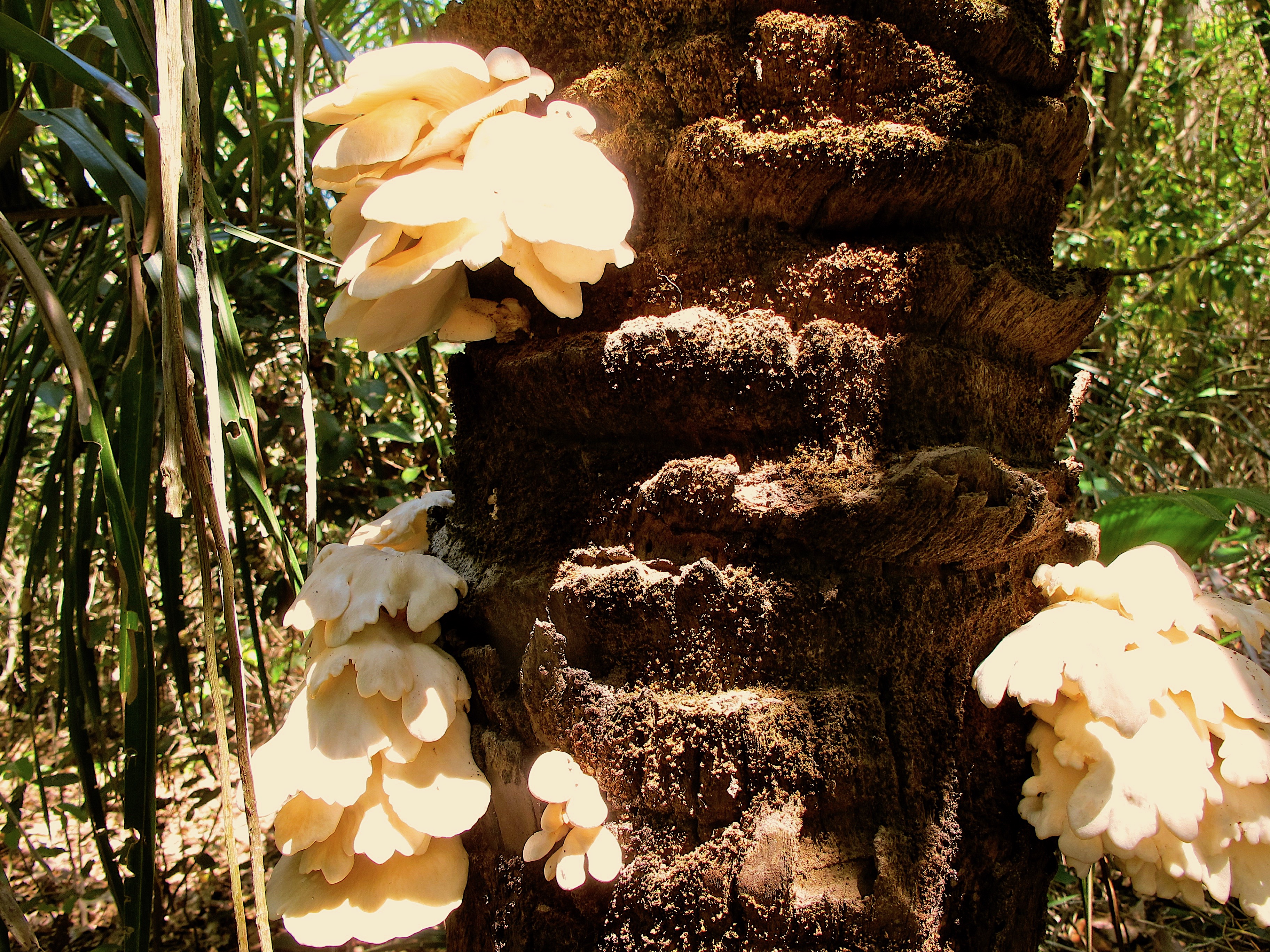
Adventurouspirits
After lunch and a rest we head off again in search of more wildlife. Iguanas disappear into the bush, and then suddenly we see two Jabiru storks high in the tree. They are the largest flying bird in Central and South America. Males can reach up to 5 feet. The female flies off gracefully but the male stays behind with the young and screeches to us. We watch in awe at this magnificent bird in the largest nest I have ever seen. We continue to explore the area, macaws and other birds constantly flying past or resting on branches. Nelson constantly showing us the wonders of the pampas. Chimo heads off in search of a sloth. He comes back excited he found a porcupine resting high in a tree. I am amazed at both his ability to spot wildlife and the camouflage of the porcupine. Later we spot several sloths all hanging from the branches of cecropia trees. The sloth is a gentle animal feeding on the leaves of the tree. It moves slowly and together with brownish colouring blends into the tree itself protecting it from its main predator the Harpy eagle. It only comes down the tree once a week to defecate and then returns back up the tree.
Enlarge
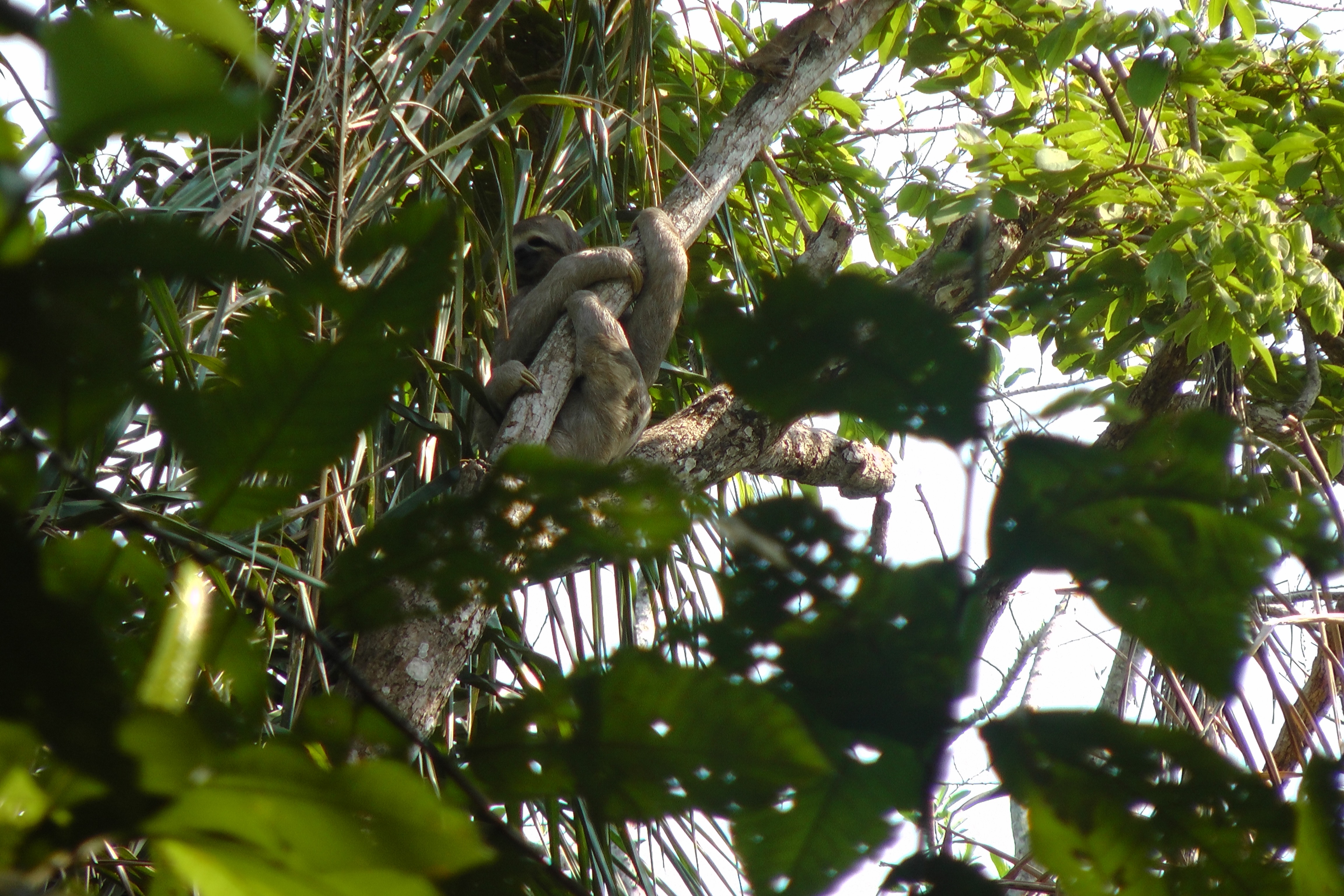
Adventurouspirits
After supper, Nelson tells us to check our bodies for ticks. I find eight of the critters clinging to my legs and back, sucking my blood into their bloated bodies. We are reassured they don’t carry any diseases. Tom is nursing his swollen neck and hand from several fire ants bites. Everything I have on is wet. Bats fly about eating the millions of mosquitoes that want to feast on us. I am tired but happy and am soon asleep on my prison bed.
The following day we find a canoe filled with water. Nelson and Chimo bale out the water and we set off down the Yacuma River in search of Amazon pink dolphins. We hear them before we see them, snorting and splashing in the water. We travel around the bend in the river and see lots of them playing, swimming and leaping, their pink bodies splashing against the brown water. They follow us and as we travel up the river. Tom wants to swim but I promise him I will divorce him if the caimans don’t get him first. He is confined to the canoe. We spend the day canoeing the river watching the wildlife that calls the Yacuma River home.
Enlarge
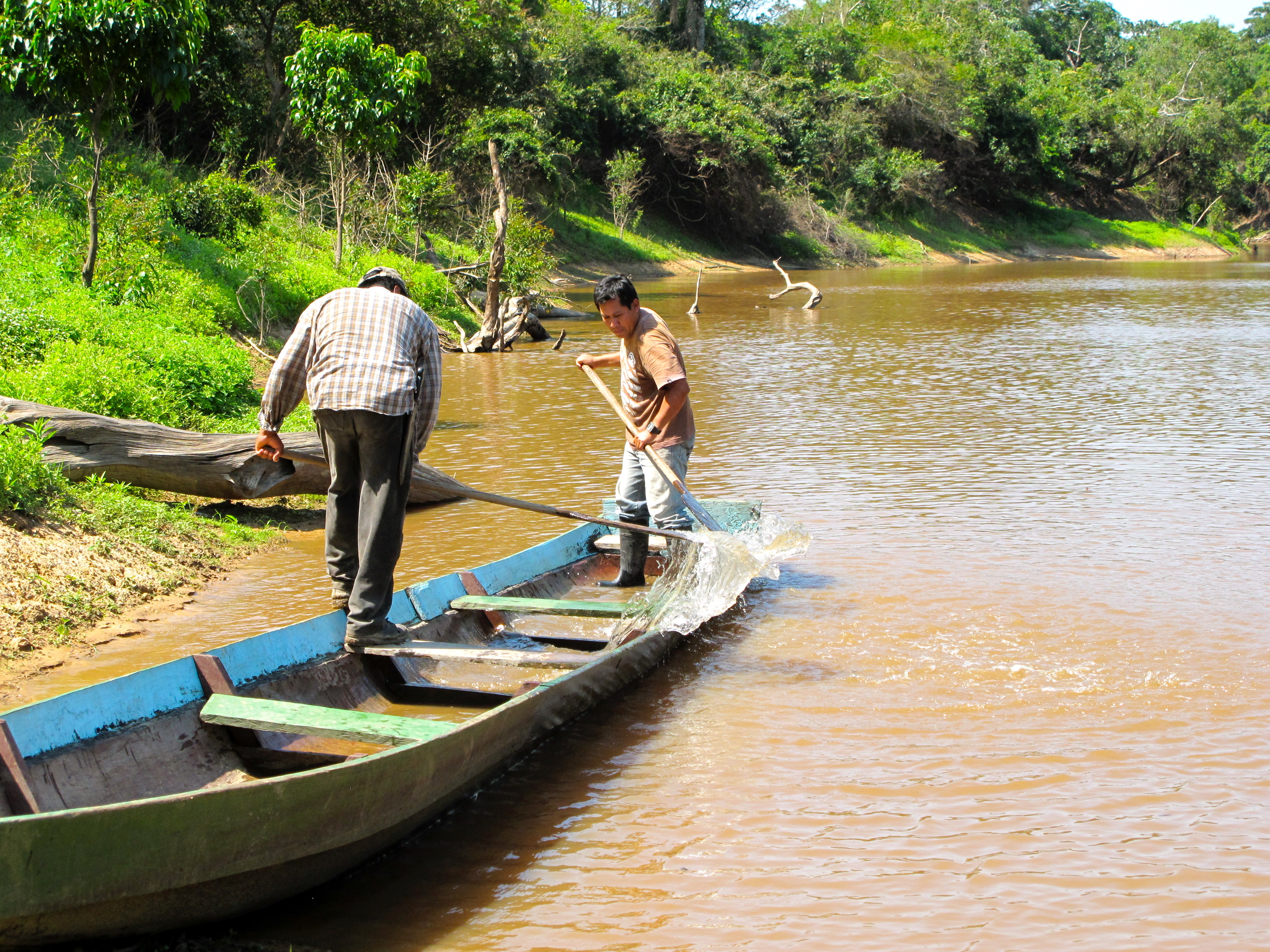
Adventurouspirits
The wildlife was stunning and Nelson, Chimo and Jackie gentle and caring. We learnt about life in Bolivia about growing up without electricity or running water in large families. We learnt about their fears of the coming changes and potential destruction to the forests and pampas, which they love. We made new friends.
At the end of our stay, we were tired, full of bug bites and swellings. The relentless heat, the constant sweating and slapping of mosquitoes had exhausted us. We looked like we had been dragged through the forest and pampas; not hiked through it. Every thing was covered in mud and smelly. I wondered if our boots would recover, I thought I could throw out the socks.
The following day our driver Pedro arrives by motorbike to drive us back to Rurrenabaque. We packed up and after lunch said farewell to Chimo. The track was not any drier in fact it seemed worse as we made our way slowly through the mud and flooded grasslands. The car struggled and after 40 minutes we heard the tires make that awful sound we know so well; we were stuck in the mud.
Enlarge
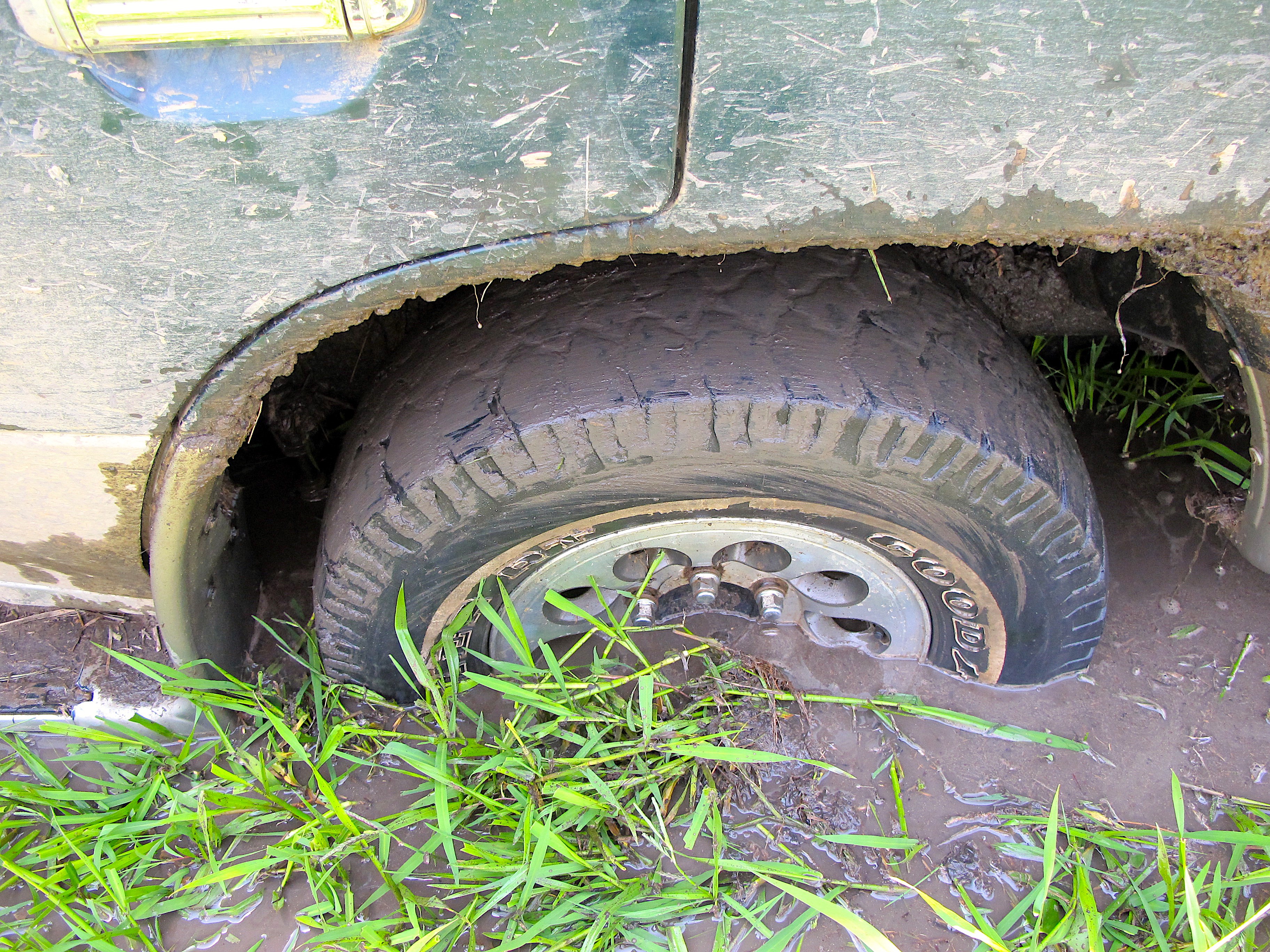
Adventurouspirits
We all clambered out and sunk up to our ankles in water and mud. Pedro, Nelson and Tom surveyed our situation. They had no equipment or tools except a machete. We are hours away from any community. We have no water or food on board. We are stuck under the heat of the day in an open area watched by water birds, frogs, snakes and bugs. We are out of cell range coverage. It was 2pm and everyone begins hiking back towards the forest to begin gathering logs, palm leaves and sticks. The plan is to build some kind of sand ladders/ramps. A leverage system was constructed so that the car could be lifted a bit. The struggle began; we all worked under the scorching sun, sweating struggling to put palm leaves and small logs under the tires.
Enlarge
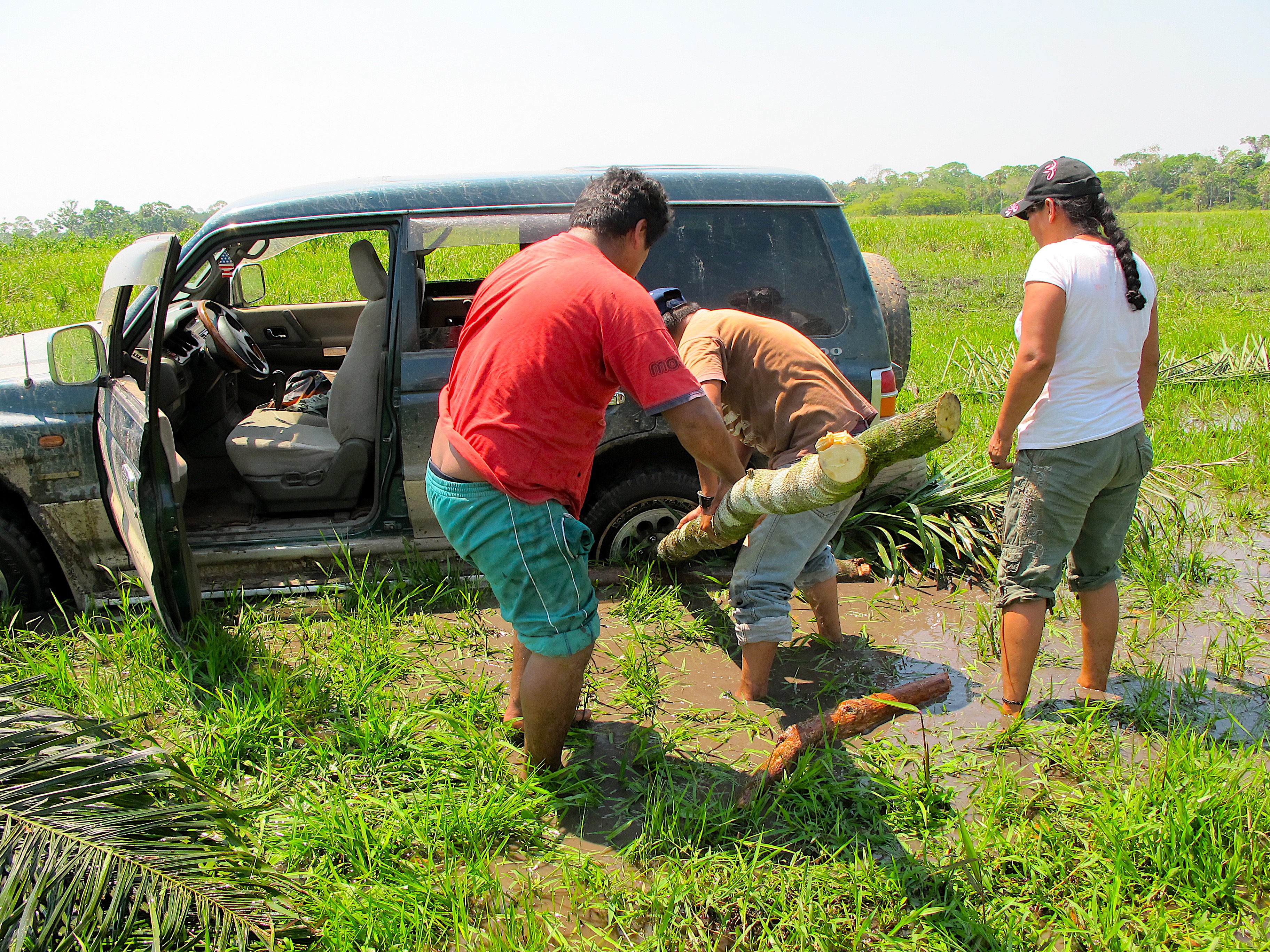
Adventurouspirits
Two men arrived on a motorbike and join the now desperate attempts of trying to move the car. After an hour they left, we too were beginning to believe this car would never be moved without begin towed. Everyone was thirsty but persisted in all efforts returning to the wooded area for more supplies. Chimo arrived later with a spade, the message had gotten to him that we were stuck. The simple hand made spade soon broke. It was starting to get late and soon it would be night. Tom and I considered our options we could hike back to the hacienda, we could send an emergency message over our SPOT; we could stay and continue this desperate but apparently futile attempt to move the car. Our main concern was lack of any drinking water. I looked at the muddy pool, around us glistening in the sun with frog egg slime and other life. We also had a plane to catch back to La Paz but that now seemed improbable.
Enlarge
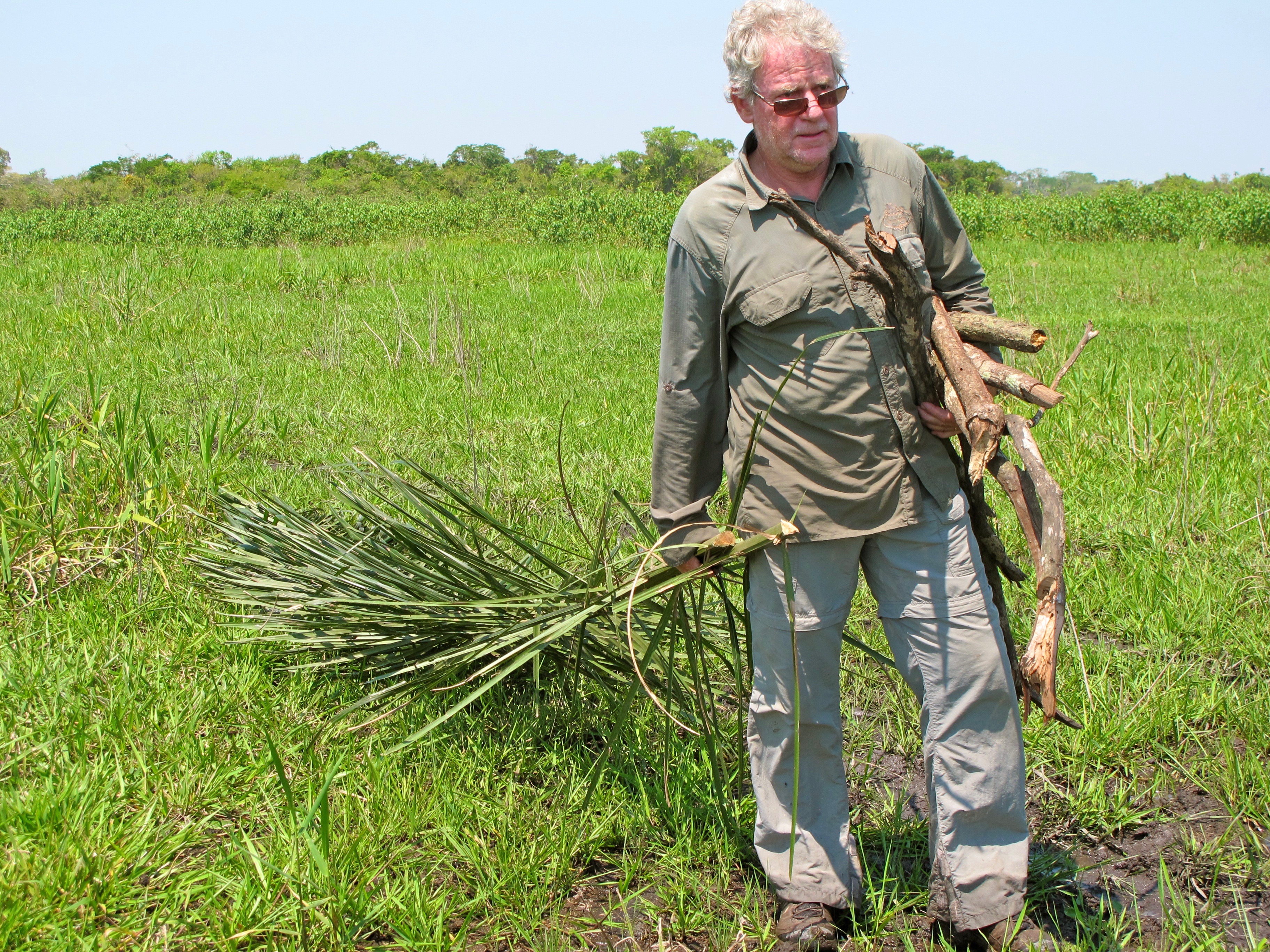
Adventurouspirits
Enlarge
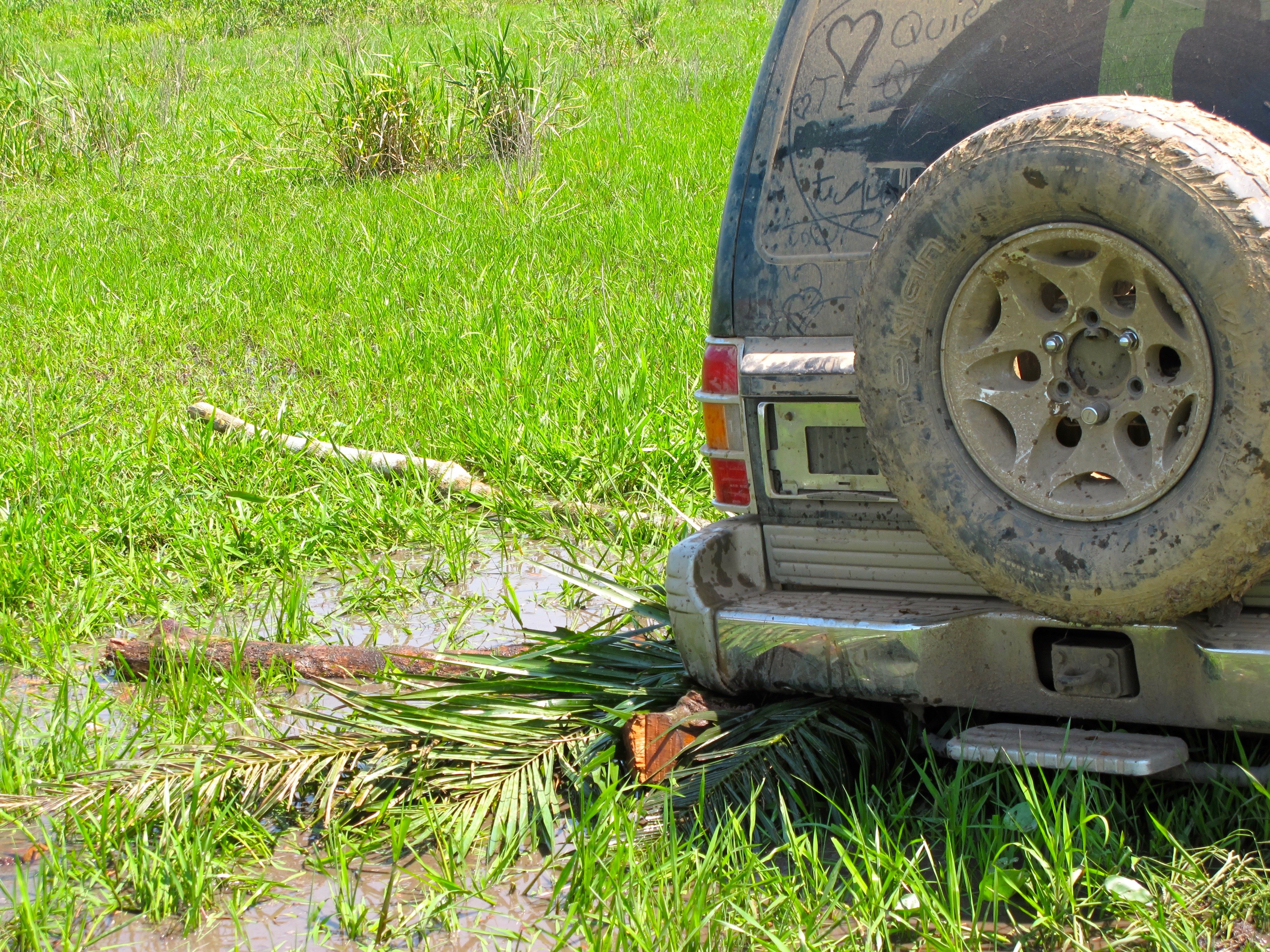
Adventurouspirits
Enlarge

Adventurouspirits
Enlarge
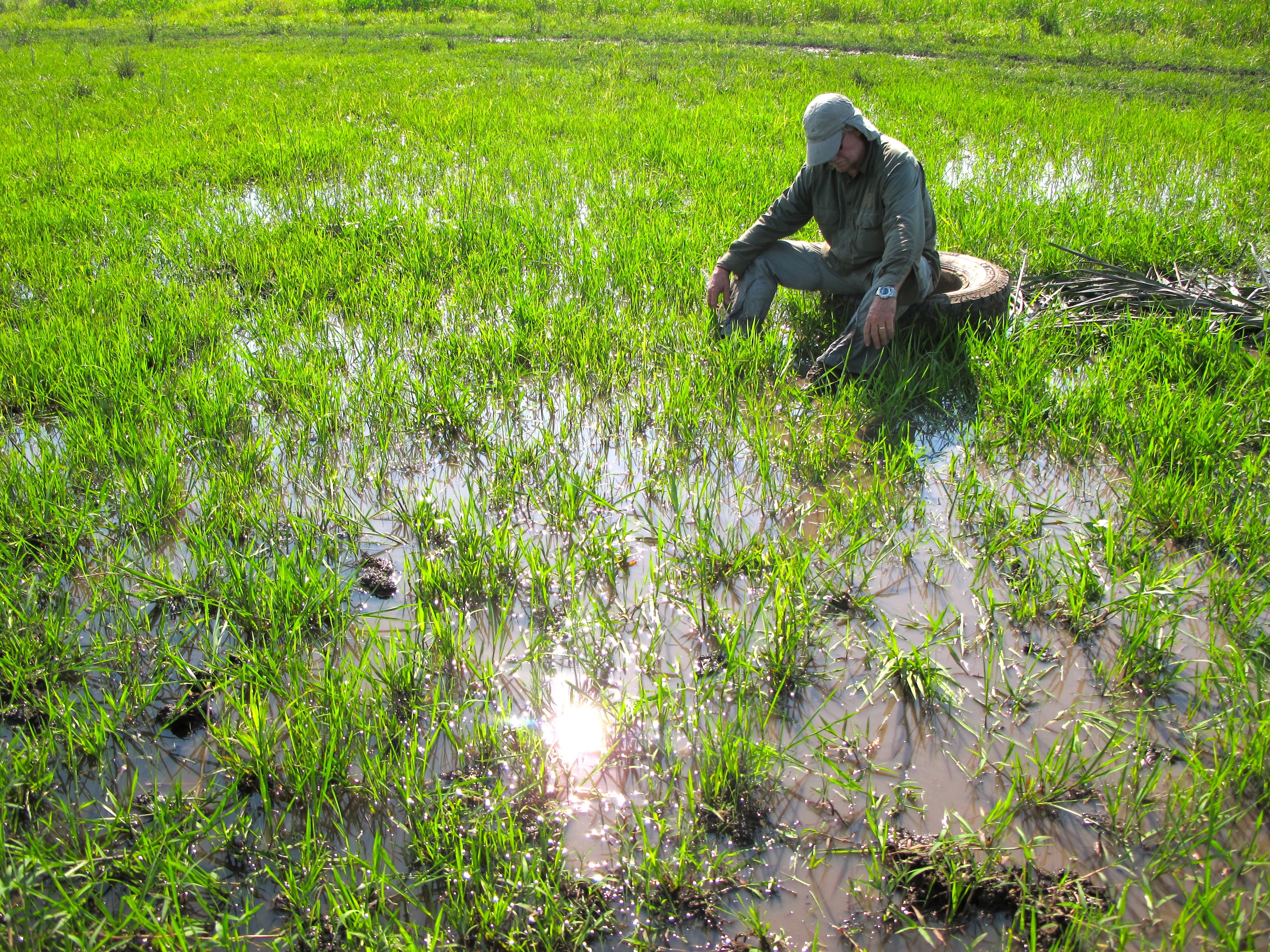
Adventurouspirits
Chimo and Jackie set off on his motorbike to see if they can rally some assistance from any nearby community, We are not optimistic as these small communities consist of several families with not much more than a few farming implements and some fishing equipment. They have no electricity, no cell phones, no tractors or trucks.
They return thrilled as they found a man with a motorbike carrying a load of crop on the back. He could take me back to Reyes the nearest village about a 2-hour ride through the forest and pampas. Chimo could take Tom. We hopped on to make it out before dark. We sorted out our luggage leaving most in the truck and taking only our valuables in our little backpacks. I squeezed in behind Manuel and the load of crop on the back of his bike. He put my backpack on his chest and we all set off. Splashing through the water and wiggling through the mud we waved good-bye to Nelson, Jackie and Pedro wishing them luck. Hoping we would see our luggage again.
The bike swayed and I hung on for dear life. I was told not to put my legs out when we were going to tip, that was his job. The branches smacked my knees, I watched constantly as I needed to duck when passing under larger branches. We stopped to push the bike through really deep mud and water and then get back on the bike. The pathway gave way to a drier dirt road and he sped up. I soon felt my self flying through the air and landed with my leg trapped underneath the fallen bike. We were both tangled in the vines and bushes. I struggled to get my leg untangled from the vine and from underneath the bike. He struggled to lift the bike as he was caught by the backpack. We looked a ridiculous sight and we could only both laugh at our situation as neither of us was hurt. Tom and Chimo who were on a smaller bike caught up with us as we were both getting back on the bike. Tom wondered how I was doing.
“Great” I said, “I love this motorbike thing I think we should get one”
He wasn’t as enthralled. He was on a small bike and as he bounced around his manhood took the beating sliding down towards Chimo he would try and pull himself back.
“Good thing we don’t want kids again” he said.
“Hang on there,” I replied, “only about another hour and we should be in Reyes, then hopefully we can find someone with a car to take us to Rurrenabaque.”
Enlarge
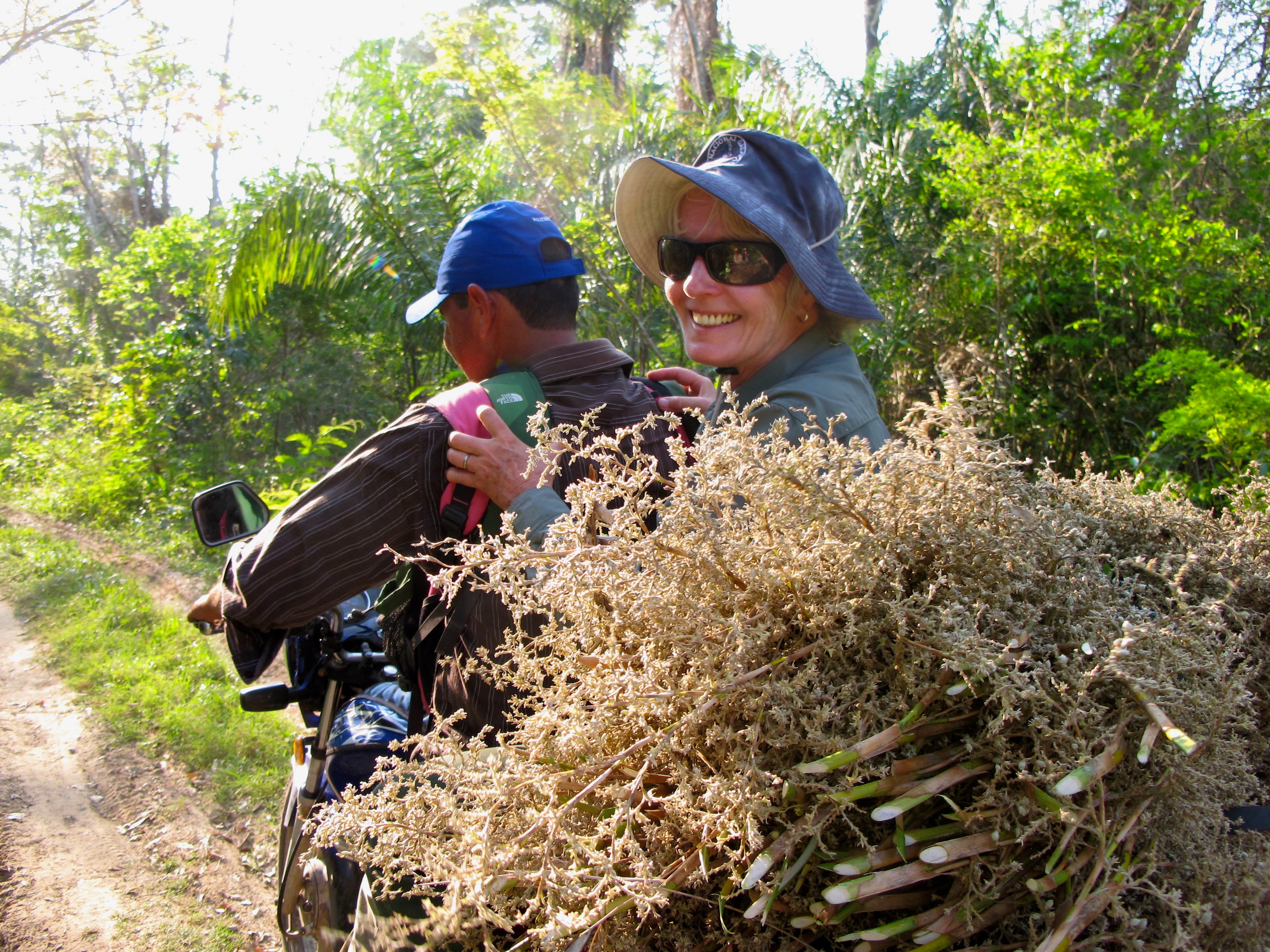
Adventurouspirits
Enlarge

Adventurouspirits
Enlarge

Adventurouspirits
Enlarge

Adventurouspirits
If we looked like we had been dragged through the jungle before we left on our return journey by the time we reached Reyes we now looked like we had been through a war zone. Covered now not only in mud, sweat but now dust, our multiple bug bites all inflamed and swollen.
We arrived back in Rurrenabaque to discover the protestors had shut down the airport, setting tires aflame on the runway. All flights had been cancelled. We can’t help but believe that putting a road through this pristine wilderness would destroy the sloth’s home, bring down the Harpy eagle and Jabiru nests, chase away the monkeys, give the butterflies and other insects no place to hide and our grandchildren Samantha and Jakob would never be able to experience the adventures and thrill of hike through such a biodiversity place on the planet.
Our jungle experience was more than we anticipated or planned!! We went with the locals and struggled through the jungle and pampas along with them. We learnt more than just about the wildlife, fauna and flora we learnt about the people who are born and live their entire lives living off the gift of nature. Please help take care of our planet. It is the only place we have to live.

I couldn’t help but chuckle at this one. There is no way in hell I would have had the nerve to drive on that ferry, never mind removing the road blocks. Keep up the good work of making my dreary world alive and exciting!
You are a lucky couple! Road blockers are not that friendly in all South American countries.
At least in Chile they aren’t.
Good luck and have a safe trip.
Nice stories of Bolivia, we can’t wait to go there! Hope you won’t find many more road blocks.. We are still camping in Cusco, have some rest before the altiplano! Hope to meet you there somewhere.
Bolivia is a very cultural country with a lot of very colorful and diverse culture and is full of many amazing things, Greetings
The cholitas is amazing! I would not want to mess with her. Must have been a very interesting spectacle.